Snippetjeetry
Table of Contents
- 1. Prathamesh Godbole maps
- 2. mānasataraṅginī
- 3. maitravaruna
- 4. Param Caitanya
- 5. aayush singh
- 6. shrikanth krish
- 7. important philosophical themes
- 8. Prathamesh Godbole
- 9. TrueIndology
- 10. Akshai1993
- 11. Ugra
- 12. reconstructions
- 13. misc history
- 13.1. Kumārila Bhaṭṭa comparative linguistics
- 13.2. Water wheel
- 13.3. Mechanical devices in ancient India
- 13.4. dīpāvalī
- 13.5. giraffes
- 13.6. agrammes
- 13.7. mumbai
- 13.8. hun assimilation
- 13.9. muhammad
- 13.10. voltaire on india
- 13.11. Chanakya Neeti is just Neetisaar from Garuda Purana
- 13.12. Famines never visited India
- 13.13. mumbai etymology
- 13.14. darlymple epstein
1. Prathamesh Godbole maps
1.1. Darkest before the dawn
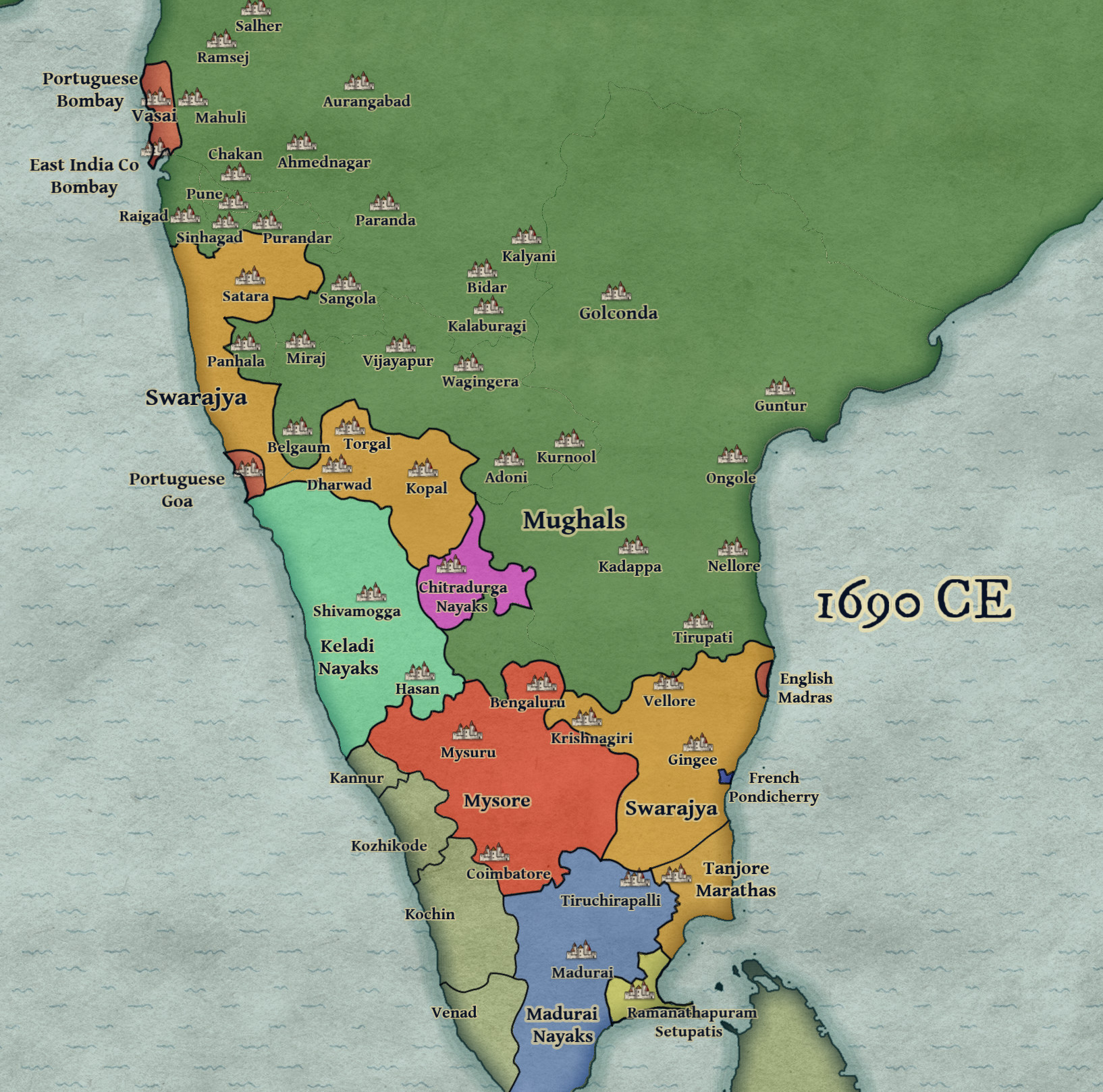
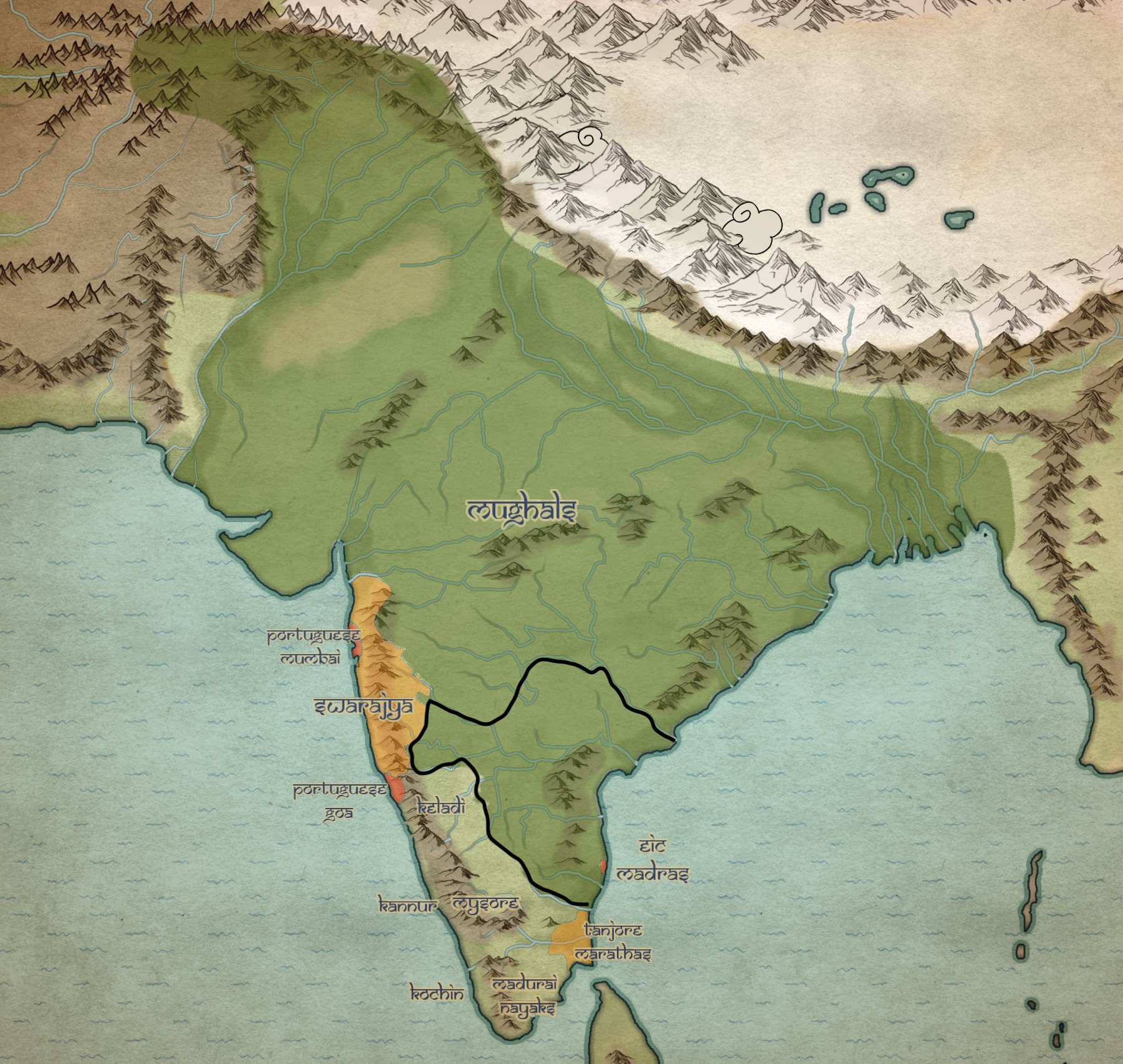
1.2. Swarajya at the time of Bajirao
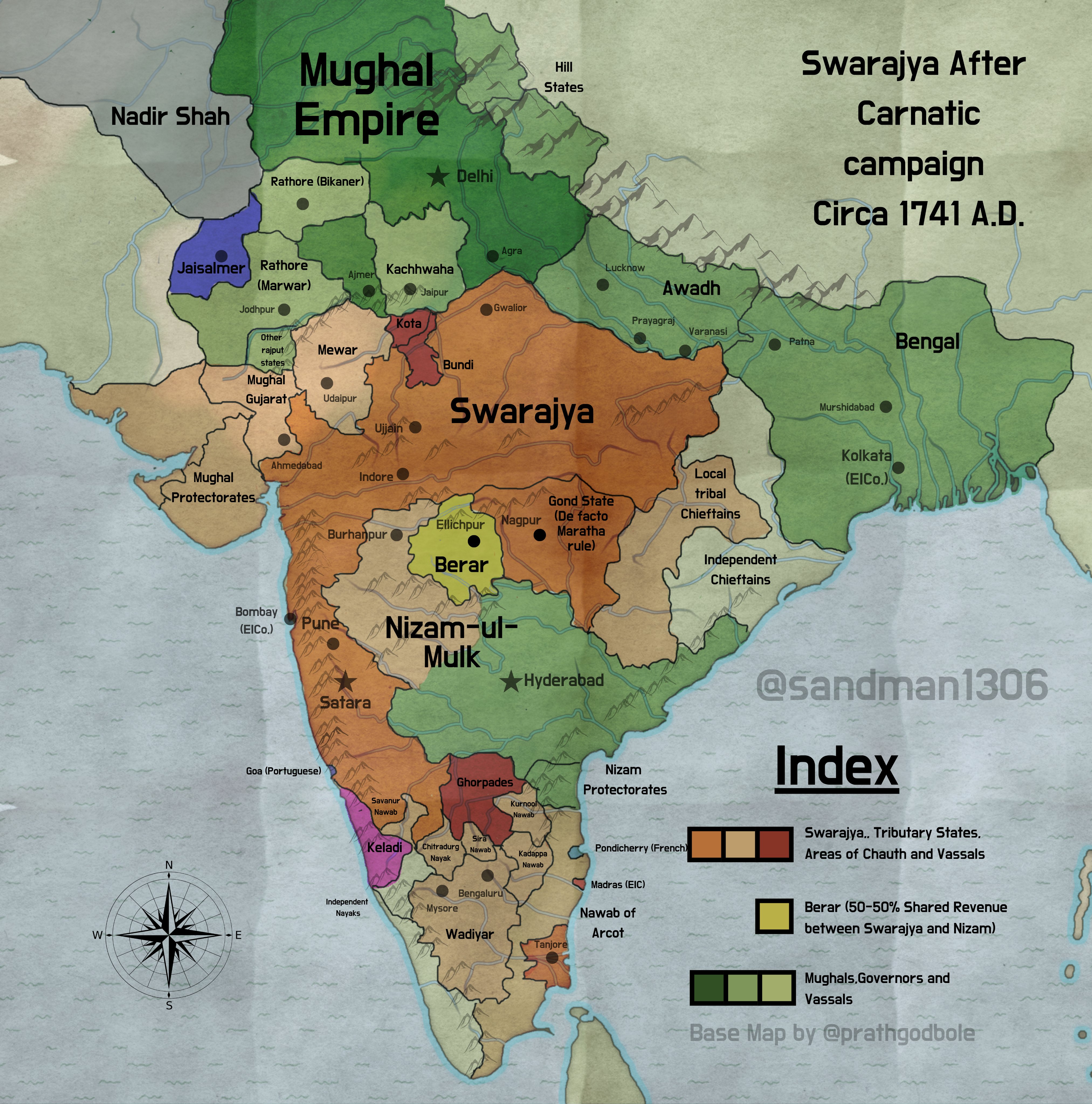
1.3. Swarajya peak
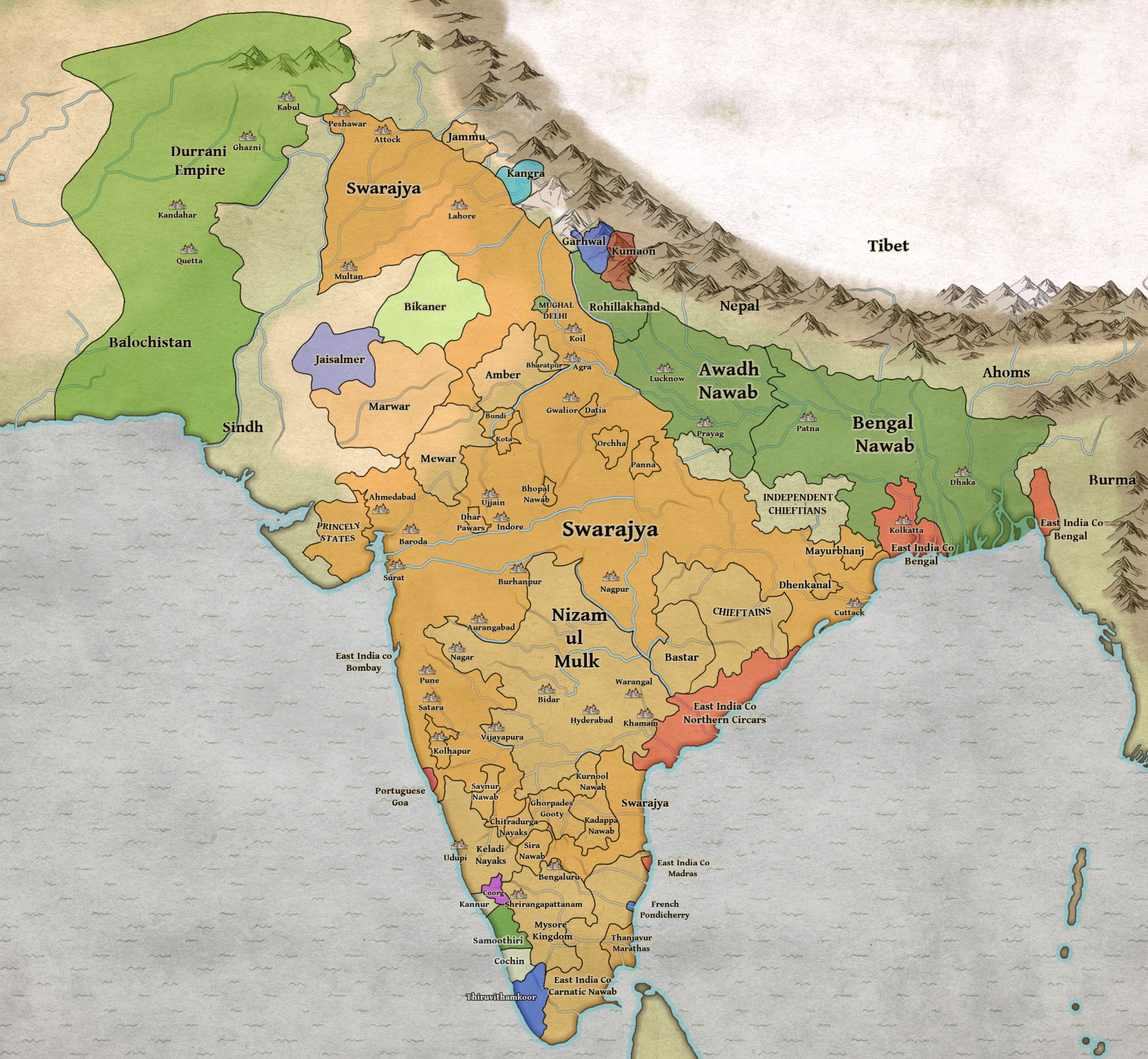
1.4. Panipat
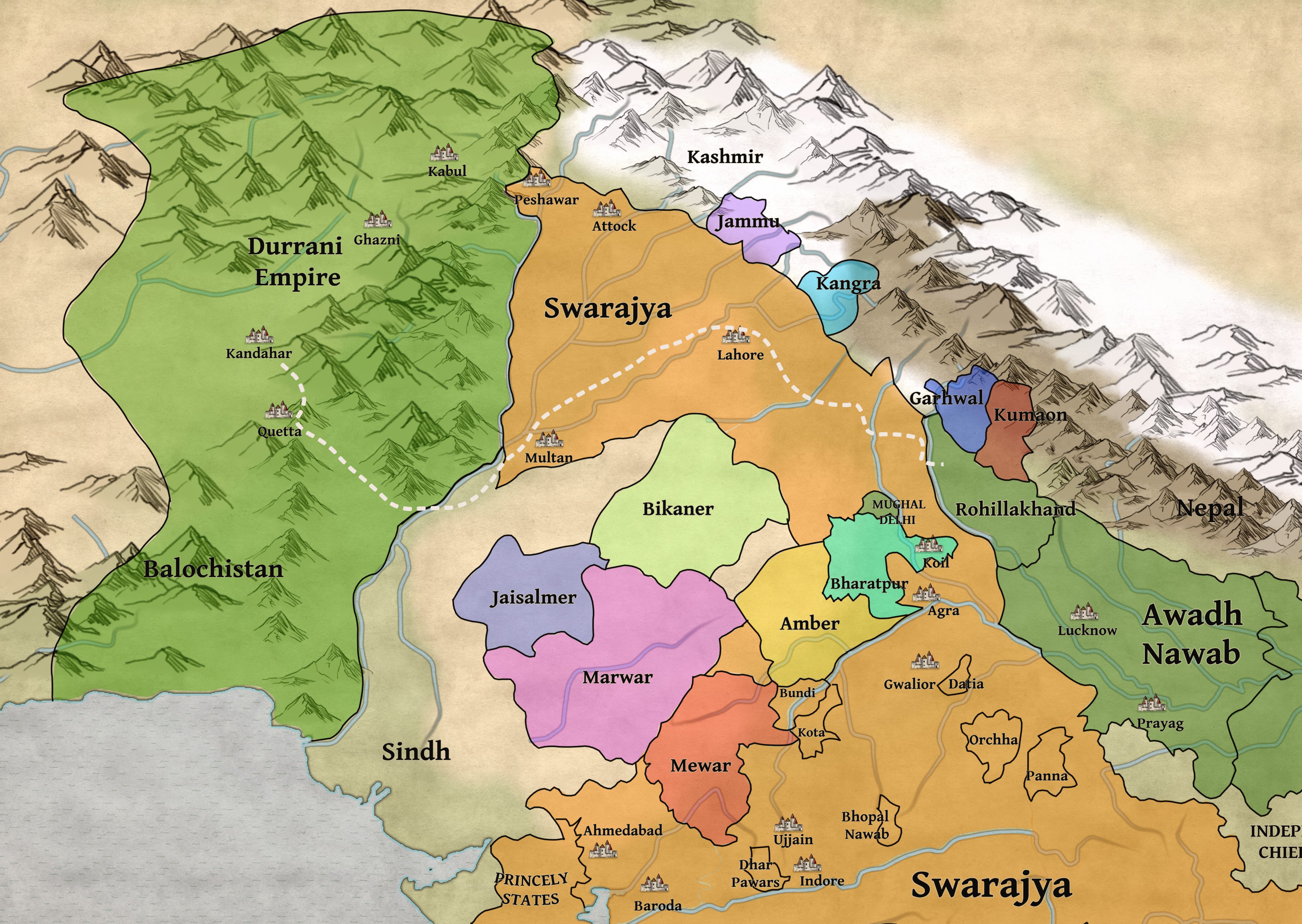
1.5. Swarajya at eve of British capture of Delhi
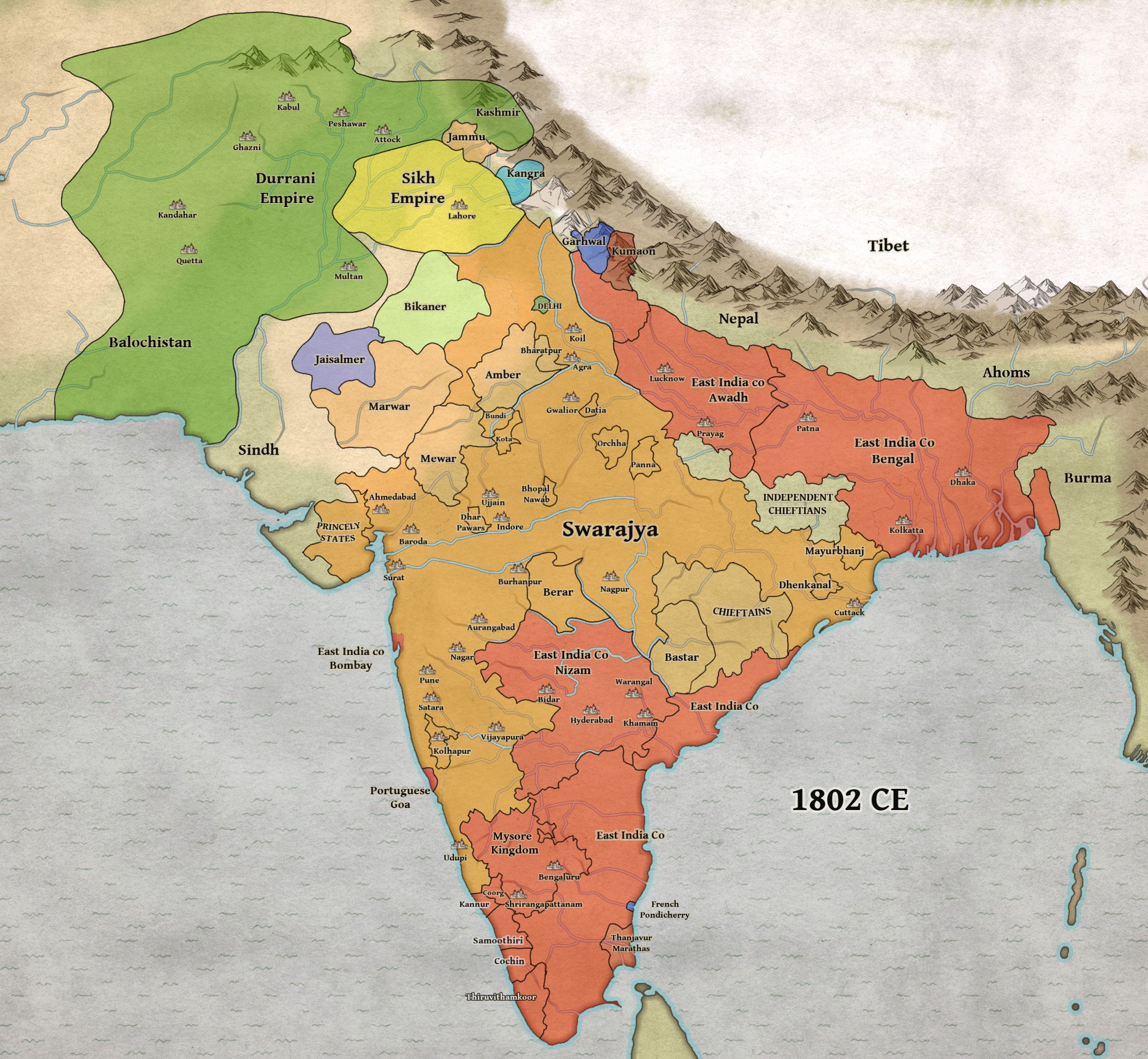
2. mānasataraṅginī
2.1. yantras in Śaiva rathayātras
An account of the shaiva rathayAtra from the shivadharma. I’d like to draw attention to the following: 1) Note the use of wooden automata of mAtRi-s, yakSha-s and gaNa-s; 2) note the use of other machines for fire and water displays; 3) The chakra-yantra is notable.
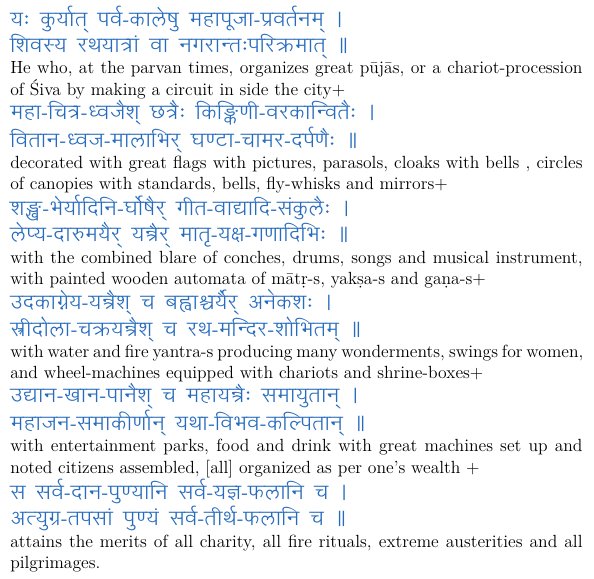
I believe it’s one of the earliest mentions of a giant-wheel or a horizontal spin-wheel. 4: various machines are set along with entertainment parks to produce wonderment. This points to an active culture of such automata long before king bhojadeva. This feature is largely lost in modern rathayAtra-s.
Though occassional displays might exist like I think @madrasmami23 had posted one. This emphasis on yantra-chamatkAra-s has a close parallel in later Platonic tradition of theurgy where the yavana theorists propose use of such yantra-s for involving the lay in religion. More generally such activities might be compared to other such shaiva festivities as we had described here:
After this this the shiva-dharma promises that he who does this kind of shiva-ratha-yAtra after enjoying shivaloka: जम्बूद्वीपाधिपः श्रीमांस् तस्यान्ते च भवेत् पुनः |
He thereafter again becomes the emperor of the whole of the Indian subcontinent: The ideal of single emperor for the subcontinent is clearly seen and the reflects the image of the gupta when the core of the text was likely put in place.
3. maitravaruna
The Kalachakra Tantra is unique in that it is one of the few Sanskrit works that actually analyses & references the religious practices of the Turkic invaders in real time.
Although ascribed to the Buddha, the text provides one of the earliest descriptions of Islam in India
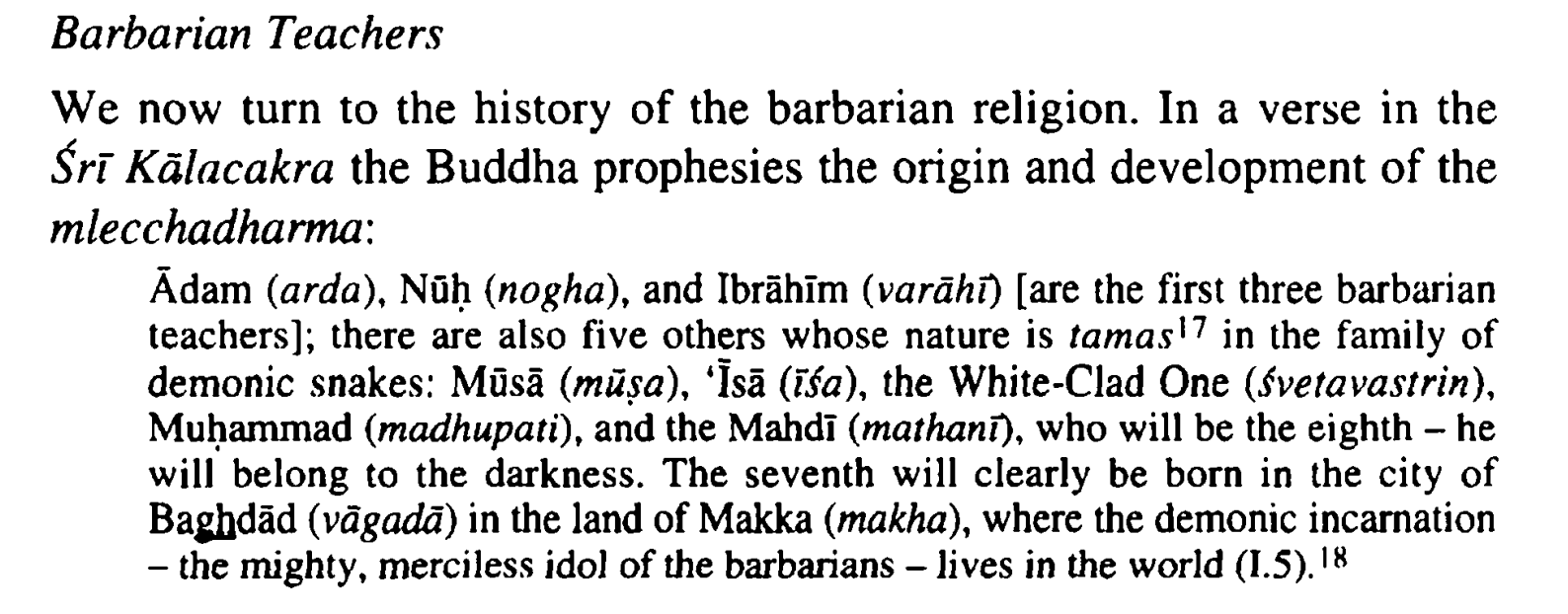
The text references a rather impressive list of Arabic religious terminology.
All the while using puns and wordplay to insult the Turushkas with references to wine and pigs
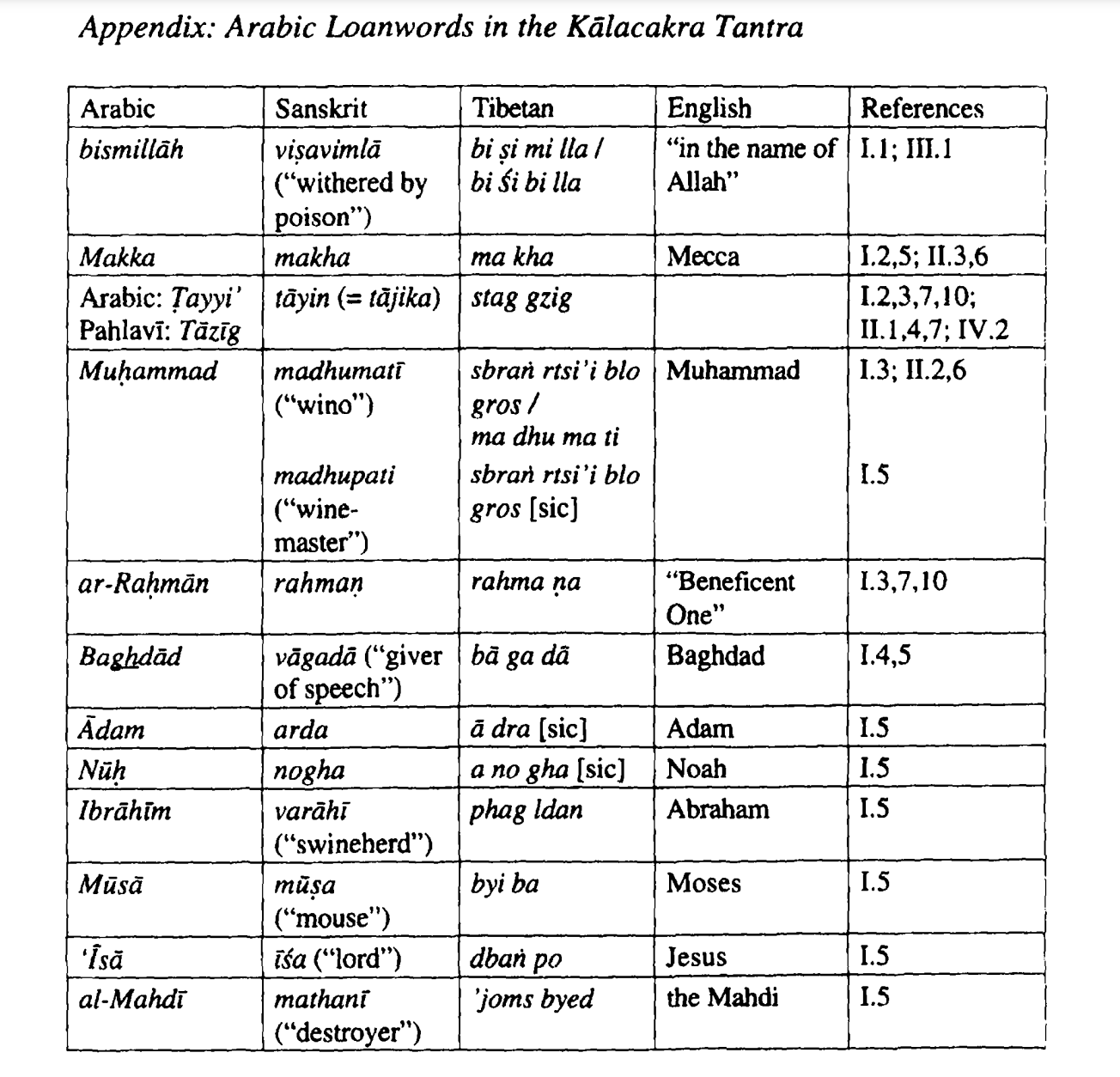
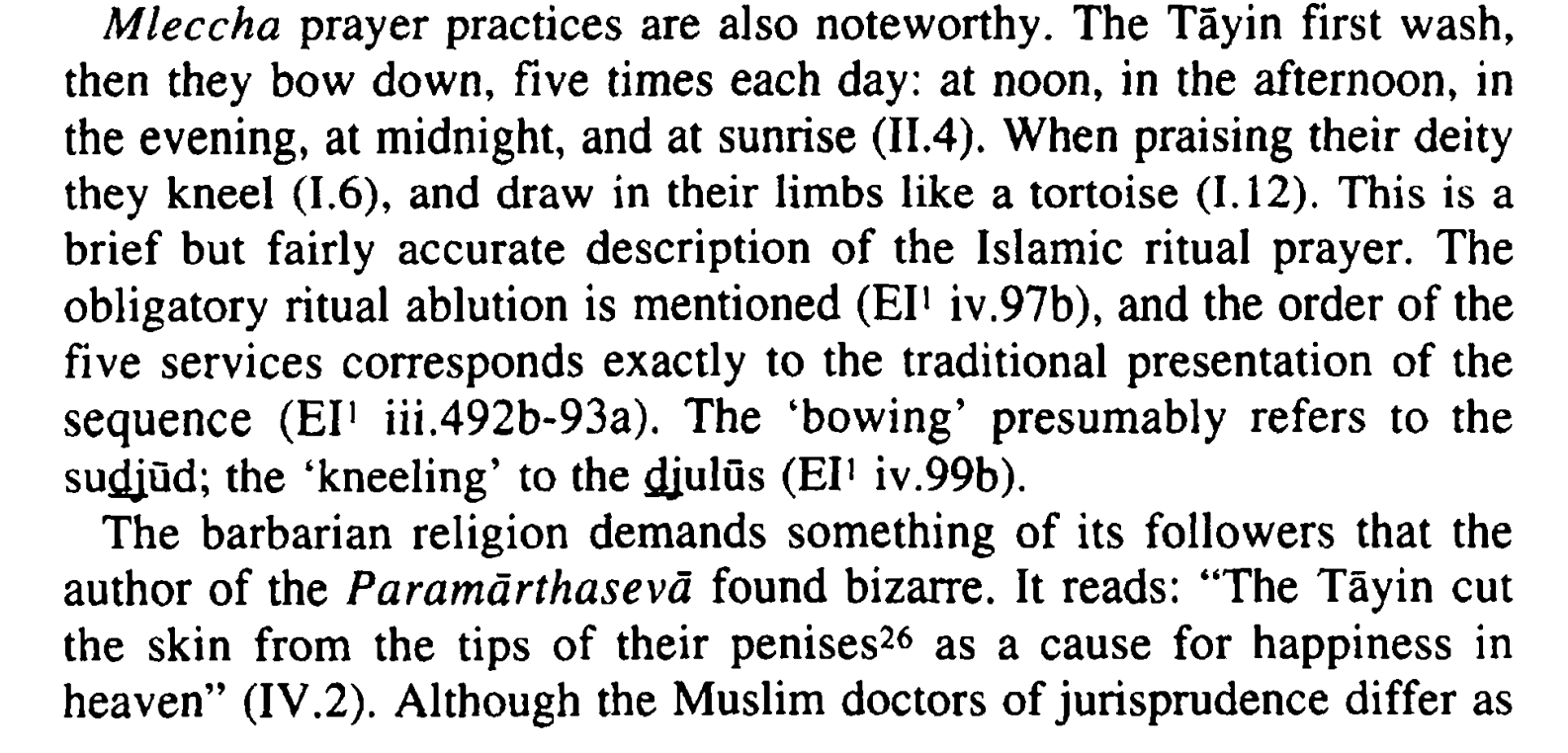
4. Param Caitanya
4.1. buddha studied ramayana
Maitreyasamitināṭaka composed by the Vaibhāṣikya Āryacandra.
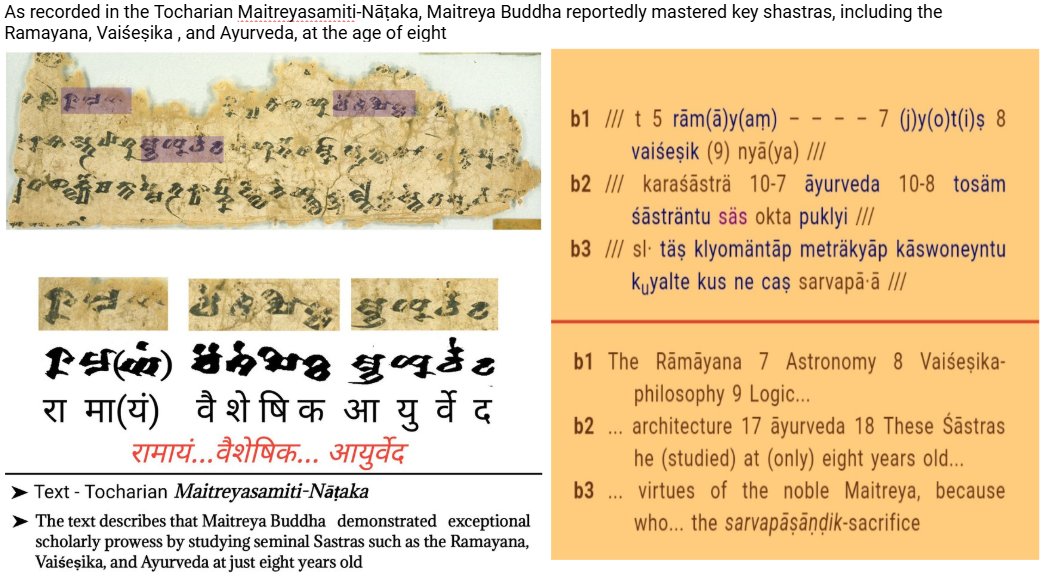
4.2. various theological sects
Tripitakas very well known who Krishna and Balarama are
Cullaniddesa of Khuddakanikaya mentions the worship of different deities along with Krishna & Balarama, this description contradicts with Ghata-jataka
It also mentions the worship of Jaina deities Manibhadra, Purnabhadra
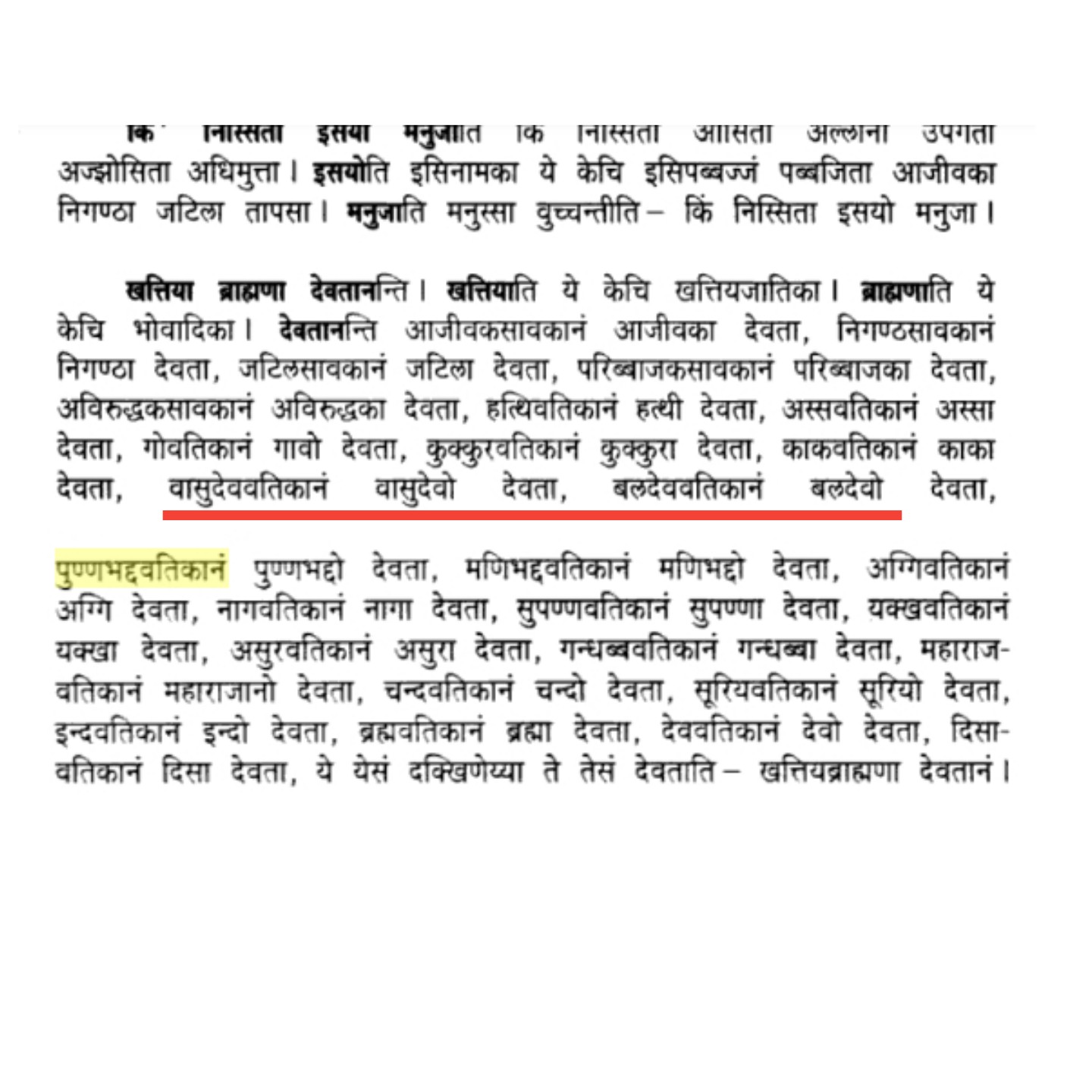
5. aayush singh
Extremely rare issue of a King named Vikrama from Ujjain city state, 1st century BCE.
In all likelihood it belongs to one of the most famous Indian King “Vikramaditya”.
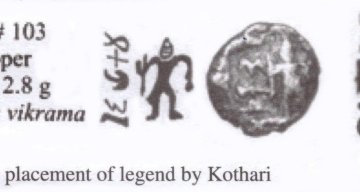
It’s from Prashant Kulkarni paper – quite recent:
6. shrikanth krish
6.1. yoga
Yoga in India appears to have two lineages
- Bhagavad Gita -> Patanjali Yoga Sutra -> Vivekananda
- Amritasiddhi / Khecarīvidyā -> Dattatreya Yoga shastra, Siva Samhita -> Hatha Yoga Pradipika -> Gheranda Samhita -> Kuvalayananda / Sivananda / Krishnamacarya and their pupils
The former is the one people talk about a lot, in a “Vedantic” context
It is “Yoga as philosophy”
The latter is what influences Yoga on the ground
The tradition of Hatha yoga with its heavy early influence of Tantra (both Shaivite Tantra and Buddhist Tantra)
The great Yoga gurus of our time pay tributes to the Vedantic Yoga tradition
Which is well deserved. The tradition of Gita, Yoga Sutras
But their own “Yoga” is more influenced by the Tantric texts - the second lineage
Generally speaking, the last 500-1000 years have seen a decline of both Buddhist Tantra and also Shaivism
So when modern “haTha Yogis” think of their traditional inspiration, they use the texts close to the Vedantic tradition, which are likelier to strike a chord
The haTha yoga texts in contrast remain understudied and somewhat ignored
They lack the “high status” of Patanjali’s Yoga sutras.
Maybe because of their focus on postural Yoga and their idiom being v different from the high Vedanta of the Gita
When modern “scholars” like Meera Nanda have attempted to disregard Yoga’s antiquity, their line of argument has been -
“Yoga in ancient India was mostly abstract philosophy Modern postural Yoga is largely a 20th cen thing, inspired by Western gymnastics etc”
This is obviously wrong
Because people like Ms Nanda focus only on the first lineage - that of Gita and Yoga Sutras
Disregarding the equally rich tradition of Yoga in Tantric literature, which I outlined
This alternative lineage has had a huge influence on modern postural Yoga
Indians need to get better at branding and positioning
In modern times, there have been two instances where our branding has been brilliant and we managed to reinvent two great traditions
- Rebranding Sadir-Attam as Bharatanatyam
This was the decision of Rukmini Devi Arundale and E Krishna Iyer in 1932 MMA meeting to position the practice of Sadir Attam (popular in temples as a matrilineal tradition) as “bharatanATyam”.
Thus linking the tradition to the great bharata muni himself. And drawing on great ancient texts like nATya shAstra and abhinaya darpaNa. Thus making the tradition respectable and brahminical in a way it wasn’t in more recent history (say 18th/19th cen)
- Rebranding Yoga by connecting the postural haTha yoga practice with ancient texts like pata~njali’s yoga sUtras / bhagavad gItA (led by the likes of Vivekananda and later kRSNamAcArya’s disciples)
Again a brilliant effort to create a synthesized narrative on Yoga connecting the philosophy of it as exemplified by those v ancient texts with the haTha yogic practice that prevailed in the 2nd millennium CE.
Neither of these two branding efforts were “wrong” or an attempt at propaganda. But they were clever nonetheless.
6.2. sikhism
Up until early 20th cen, the Sikh identity was not altogether distinct from the Hindu identity in the Punjab
It was a continuum of sorts, with many families straddling both faiths and cultures. It was often common for the eldest son to be raised Sikh in many H-households.
As late as 1901, in united Punjab, Hindu population 41.3% and Sikh population 8.6%. Barely 30 years later in 1931, only 30.2% of Punjabis called themselves Hindu, while 14.3% were now Sikh
Bulk of this change was not conversion but rather the assertion of a subculture to the point that a rather heterodox indic sect began to take the shape of a distinct religion
The British indologists played a significant role in the development of this subculture and its elevation to the status of a religion altogether distinct from Hinduism
One of the key figures is Max Arthur MacAuliffe. He wrote his magnum opus on the Sikh religion in the early 1900s in which he made an impassioned plea not to confuse Sikhs with Hindus (as shown in the extract attached)
Besides academics / indologists, there were legal developments that also pushed the development of a distinct Sikh identity - like the Anand marriage act of 1909 that legitimized a distinctly Sikh marriage ritual
On top of that there was the army recruitment policy that started privileging Sikhs and other “martial” communities post 1857, to reduce the reliance of the Army on Purabiyas who had proved troublesome.
All these little developments must have seemed small back then. But small ripples in one era can have an inordinate impact on many generations to come

7. important philosophical themes
7.1. wealth
Dharma is important, no doubt, but in order to be dharmic, one needs to be wealthy as possible. You can’t pour from an empty cup.
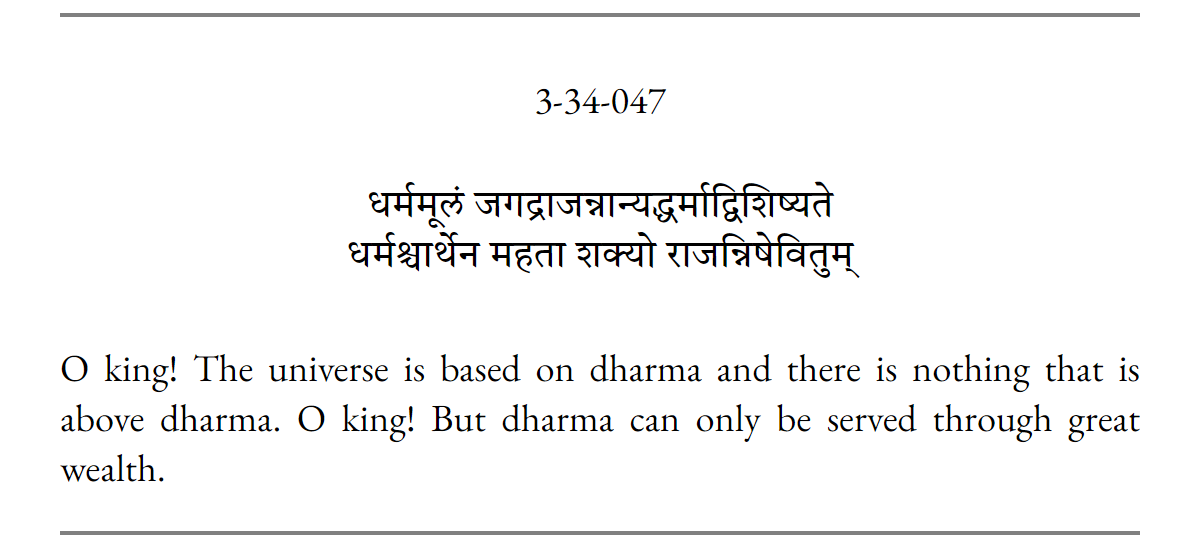
“Profit is not a dirty word” – straight outta Mahābhārata

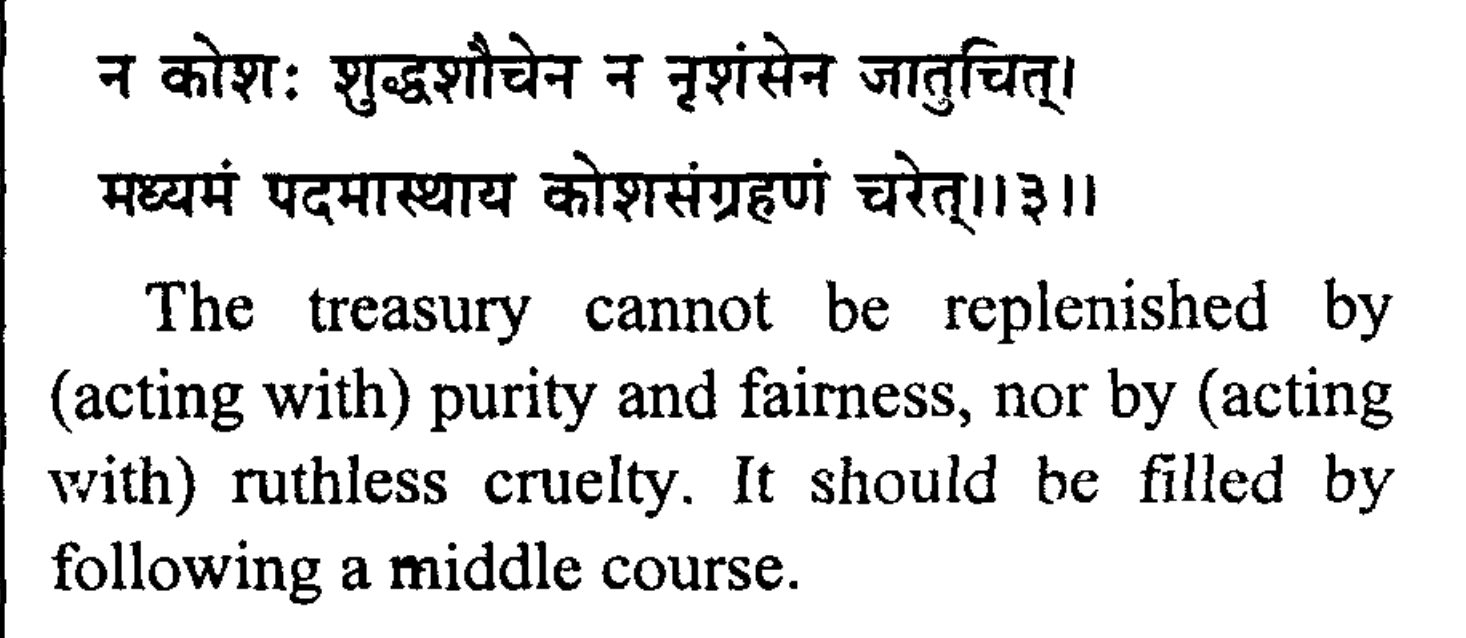
7.2. Openness to reason
Wrong attitude. In fact, Dharma explicitly rejects this.
E.g. Kumarila Bhaṭṭa says: on matters not directly pertaining to religion, we may freely learn from “western plebs”. Ādi Śankara says something similar. Manu famously says: even the lowest can have something to teach us.
श्रद्दधानः शुभां विद्यामाददीतावरादपि । अन्यादपि परं धर्मं स्त्रीरत्नं दुष्कुलादपि ॥ २३८ ॥
śraddadhānaḥ śubhāṃ vidyāmādadītāvarādapi | anyādapi paraṃ dharmaṃ strīratnaṃ duṣkulādapi || 238 ||
One imbued with faith may acquire excellent learning even from a lowly person, special law even from the lowest, and the gem of a wife even from a base family.—(238)
Reliable testimony & skill of the mlecchas (barbarians) were considered sources of valid knowledge by both the Naiyāyika-s like Vātsyāyana & Mīmāṃsaka-s like Kumarila Bhaṭṭa
This means in laukika issues like armor, construction, weapons, science any people can be knowledgable
Nyāyasūtra 1.1.7 (आप्तोपदेशः शब्दः)
Here, mlecchas are included as sources of shabda-pramāṇa by both Vātsyāyana & Vācaspati Miśra.
(ऋष्यार्यम्लेच्छानां समानं लक्षणम्). The Sages, Aryans, Mlecchas all are similar here & can be āpta (reliable) people in shabda-pramāṇā
Kumarila Bhaṭṭa goes as far as suggesting the Mlecchas are even superior in many laukika activities like house-building, silk production, armor production to the Arya-s.
[INTERJECTION: appears to me to say that we can admit the superior authority of the mlecchas on matters under such topics, i.e. we can adopt their practices in such matters where they are superior, not that they always are.]
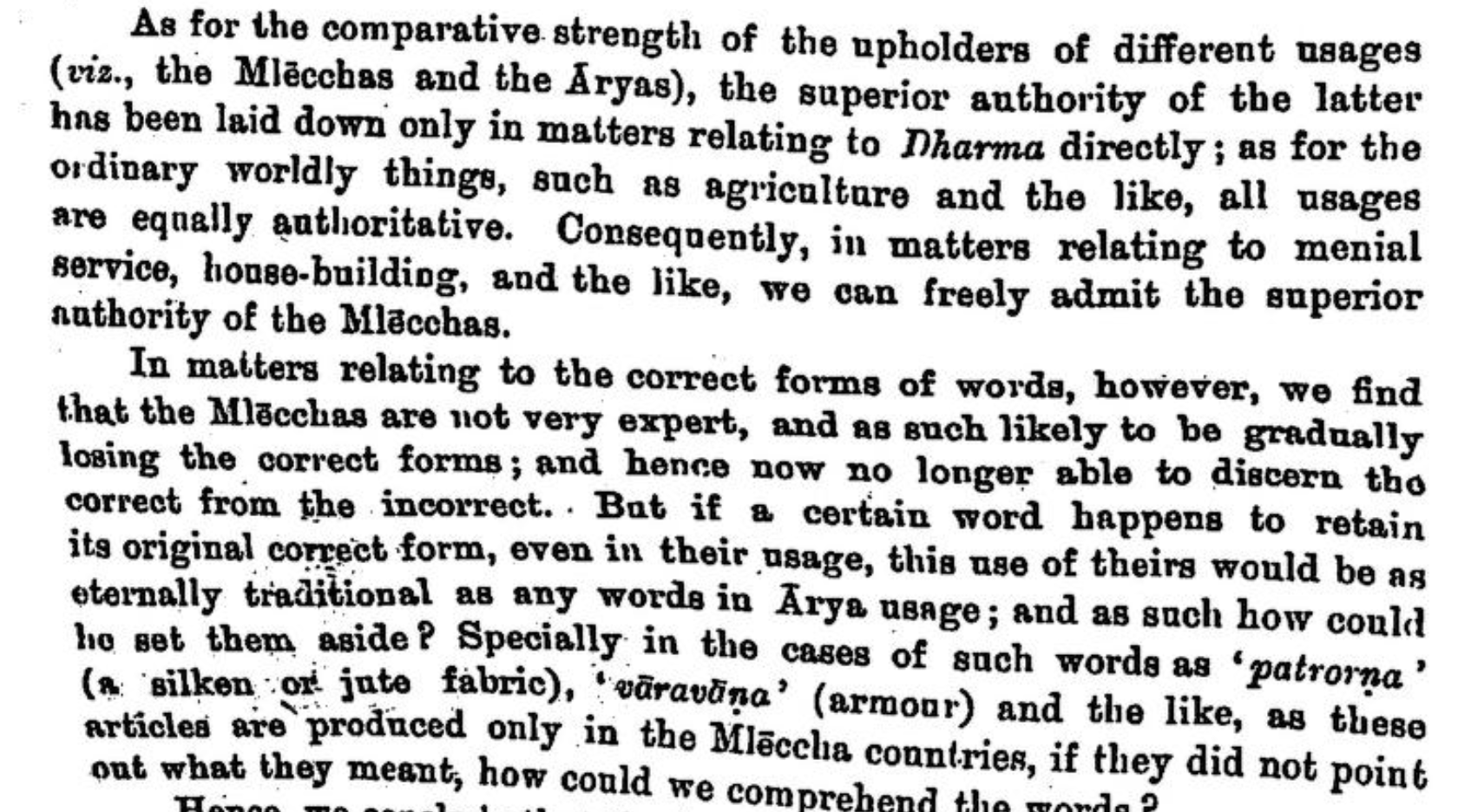
The Arya only have superior authority in religious theology, not in anything else.
Please check my comments as well in the comment section. For reasons of brevity I didn’t include in the main post. #Introduction
We hear all the time that Hinduism is a scientific religion. Usually the way this is shown is someone will quote some sloka which seems unscientific, someone else will explain the Sanskrit meaning, then again another sloka is quoted and it goes back and forth.
I will just say this - It accepts the words of science wherever it is applicable. #Because of Authority of Pratyaksha and Anumana
There are different Pramanas, evidences, to decide the truth of something. Different schools accept different evidences as authority. Vedanta schools in common hold that pramana (direct observation), anumana (logical reasoning/inference), and sabda(Sruti) are three independent sources of knowledge.
There is a hierarchy though here. To put it loosely, say that you can see a fire. Then Pratyaksha tells you that there is a fire.
Say you cannot see the fire but only the smoke rising from it. Pratyaksha cannot tell you that there is a fire. But with anumana, you can understand that the cause for the smoke is fire.
Whatever cannot be known by direct perception or inference can be known by sabda. What that could be will be explained later. So the hierarchy is that Pratyaksha is to be applied before Anumana, and Anumana before Sabda.
Sri Ramanujacharya writes the following statements in his works.
For it is an acknowledged principle that Scripture has meaning only with regard to what is not established by other sources of knowledge.
In cases of Scripture conflicting with Perception, Scripture is not stronger. The True cannot be known through the Untrue.
Srutiopapattaye’py anupapannam viruddham na kalpanIyam“ – ”even for supporting the Vedas, what is against reason or contradicts evidence should not be postulated
Sri Adi Shankaracharya writes in his works,
Surely, even a hundred Vedic texts cannot become valid if they assert that fire is cold or non-luminous! Should a Vedic text say that fire is cold or non-luminous, even then one has to assume that the intended meaning of the text is different, for otherwise (its) validity cannot be maintained; but one should not assume its meaning in a way that might contradict some other valid means of knowledge or contradict its own statement.
The validity of the Vedas holds good only with regard to matters concerning the relation between ends and means of Agnihotra etc., which are not known through such valid means of knowledge as direct perception; but not with regard to objects of direct perception etc., because the validity of the Vedas lies in revealing what is beyond direct perception.
This is why it is explicitly explained in the Vedanta Sutras that Brahman cannot be understood through Pratyaksha or Anumana and only through Shabda. If Brahman could be understood through the others then they would be the means of knowledge.
Realm of science works with Pratyaksha and Anumana mainly. Hence wherever these conflict with the scripture in their sphere of influence, the former is to be considered.
Edit - It’s not as black and white as saying to trust Pratyaksha always. For example, a mirage. It is more nuanced, please read the comments of others to understand.
Jai Sita Rama
Then is Scripture meaningless?
It is not that Scripture is meaningless. It is just that there is a hierarchy of Pramanas. Take the example of scriptures themselves. Sruti > Itihasa > Purana. So if we are presented some fact from Purana, we should try to reconcile Purana and Sruti both. But if this is truly impossible, then reject the Puranic verse. However, if it is that the Puranic verse is about something that is not mentioned in Sruti then we can accept it, because there is nothing in conflicts with.
Similarly in matters of perception, we should trust Pratyaksha. Scripture should be interpreted in such a way that it does not conflict with the perception. As with the fire cold and hot example given by Shankara, if this is really not possible then trust Pratyaksha.
Essentially this is why Vedantacharyas explains that Brahman cannot be known by Pratyaksha or Anumana and then only explains that Brahman can be known only through the scriptures.
Not because they are faulty. But that the one applying can be faulty. For example, the frog in the well. The frog cannot see anything beyond the well, and also has no logical framework to understand the concept of an ocean.
The way I understand it is that the Pratyaksha for enlightened is the Sabda for the ignorant. Those whose vision is covered by karma-vasanas cannot see the Truth. Their vision has not expanded. But for one who has seen the Truth their vision is infinity. This is what omniscience really means, the ability to know anything what they want. Basically they can see anything. This is why Avadhuta Upanishad says that the Avadhuta will think like
Let them, who are ignorant of the reality, study the scriptures; knowing (the reality) why should I study ? Let them who have doubts reflect (upon what was studied). Having no doubts, I do not reflect.
This is not true for the bound ones of course. We must continue to act in a detached manner and consider right and wrong. But the point is that it is simply Pratyaksha for the enlightened one as their vision has become infinity.
Jai Sita Rama
Found a remarkable convergence in Ancient Greek & Indian exegesis.The Neoplatonist Philosopher Saloustious & the Mīmāṃsakā Kumārila Bhaṭṭa both make a similar point on the need of divine stories/itihāsa/mythos. They say truth about divinity is concealed in…+ … the stories about the Gods so that men of all forms of intelligence can grasp their meaning. Why?
Let’s see what Saloustious says first:
“Besides, to inform all men of the truth concerning the gods, produces contempt in the unwise, from their incapacity of learning..+ ..and negligence in the studious; but concealing truth in fables, prevents the contempt of the former, and compels the latter to philosophize..Of fables, some are theological, others physical, others belonging to soul, others material, and lastly, others mixed from these.” “Πρὸς δὲ τούτοις, τὸ μὲν πάντας τὴν περὶ Θεῶν ἀλήθειαν διδάσκειν ἐθέλειν τοῖς μὲν ἀνοήτοις, διὰ τὸ μὴ δύνασθαι μανθάνειν , καταφρόνησιν, τοῖς δὲ σπουδαίοις ῥᾳθυμίαν ἐμποιεῖ· τὸ δὲ διὰ μύθων τἀληθὲς ἐπικρύπτειν τοὺς μὲν καταφρονεῖν οὐκ ἐᾷ…” Discover more Entrepreneurship coaching programs Let us see what Kumārila Bhaṭṭa says,
“And as the works (Itihāsa, Purāṇa) were composed (by Vālmiki, Vyāsa) to be understood by men of different types of intelligences.. different methods are used. Here, some men understand by injunction alone, some by exaggerated stories..+ ….Some men need lenghty stories to understand, some get the job done in short stories. The goal is that the mind of all men should be captivated [seized] by the story” प्रतिपाद्यानां च विचित्रबुद्धित्वाद्युक्तमेवैतत् । इह केचिद्विधिमात्रेण प्रतिपद्यन्ते । अपरे सार्थवादेनापरेऽल्पेनार्थवादेनापरे महता । सर्वेषां च चित्तं ग्रहीतव्यमित्येवमारम्भः Indeed, now we see both our theologians are making a similar underlying point. The myths of the Gods are not always literal. But they are meant to be taken as such by those who aren’t of a high intelligence. But the wise philosophize & find the underlying (adhyātmika) meanings. Kumārila further goes on to say the root (mūla) of all these stories (arthavādaḥ) can be…
- Shruti/Veda
- Daily experience of happiness, wealth, heroism etc
- Poetic fancy, made by the poets themselves
केचिद्वैदिका एव केचिल्लौकिका एव केचित्तु स्वयमेव काव्यन्यायेन रचिताः Saloustious gives an example - the judgement of Paris in which he gives the apple to Aphrodite. The apple is the world, Paris is a source living on sense alone. So he only sees beauty & says the world subsists by beauty alone - so he gives the apple to Aphrodite. Another example he gives is Chronos physically embodifying the energy of time. Children are devoured by their parents as time devours itself by itself.
8. Prathamesh Godbole
8.1. mongolian invasion of khwarezm
Apparently a rude Indian merchant insulting the Khwarezmian governor Inalchuq was responsible for their execution, triggering Genghis Khan’s invasion and wipeout of the Khwarezmian state entirely.
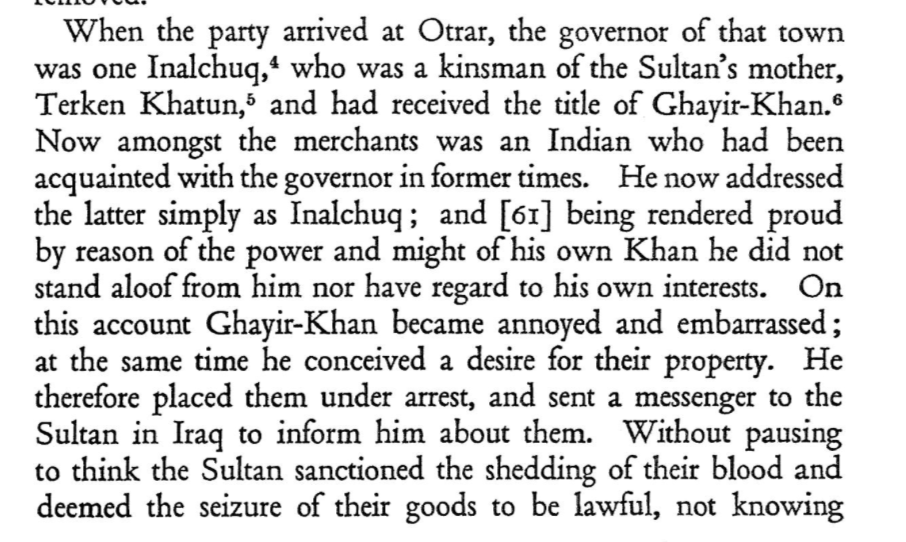
9. TrueIndology
9.1. gunpowder
According to Chinese sources themselves, an Indian Buddhist monk who brought gunpowder technology to China
In 664 CE, he discovered soils in China containing Saltpetre (primary constituent of gunpowder).
Chinese studies of Chemistry of saltpetre show evidence of Indian origin.
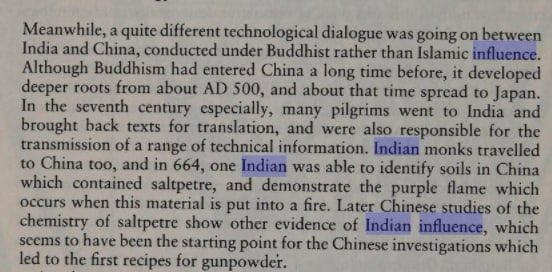
Of course, this is not to say that Chinese have no contribution to Gunpowder technology. They improvised it & made innovations.
However, the initial knowledge of Gunpowder came to China from India.
Even Scholar Roger Pauly, a hardcore Sinophile, admits “Indian inspiration”.

For those familiar with Indian literature, this should hardly come as a surprise. Indian literature contains ample references to what could be seen as an early form of Gunpowder.
Let us examine these references before jumping into the discussion about Dipavali.
Vaisampayana, the narrator of Mahabharata, describes the manufacture of smoke balls by ancient Indians using what many scholars see as Gunpowder.
According to a medieval commentator of the verse, the aforementioned smoke balls were indeed made of Gunpowder.
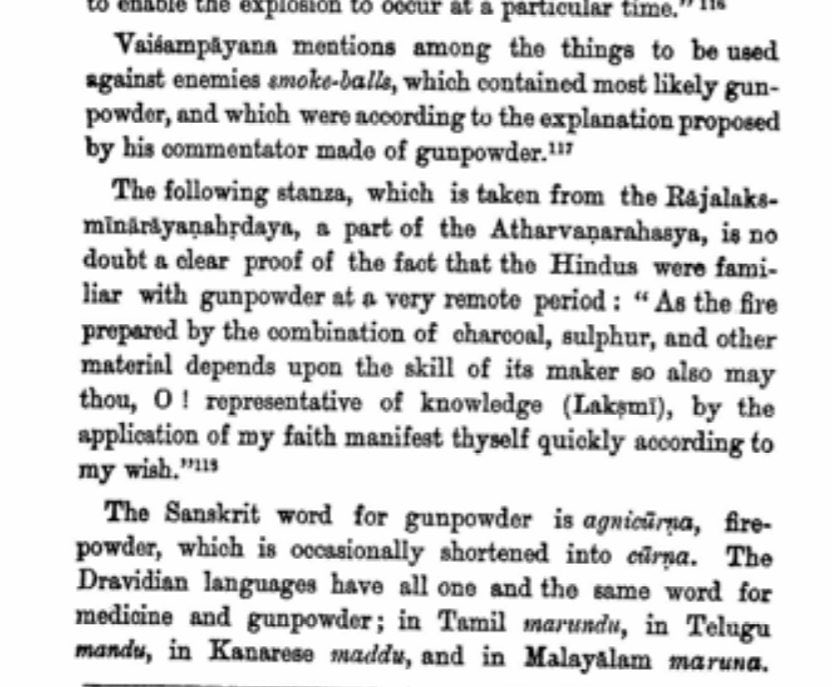
Atharvanarahasya mentions the use of charcoal, sulphur and saltpetre to make gunpowder, which are the same ingredients used even today to manufacture Gunpowder.
In-fact, workers at Sivakasi use these ingredients to make fireworks even today (more below).

Diwali fireworks are manufactured by traditional makers to this day in this manner.
This video shows traditional maker of fireworks from Andhra in action.
This is a simple form of crackers but use of such crackers is very widespread
https://www.youtube.com/watch?v=EdQ1HS1YYsM
In the above video, the Andhra cracker maker uses basic ingredients to make simple fireworks.
- Suryakara (सूर्यकार, Telugu సురేకారము)= Saltpetre
- Gandhaka(गन्धक, గంధకము)= Sulphur.
- Sand.
These were known in India since ancient age . Why would Indians borrow this from anywhere?
The etymology of the ingredients tells us about their origin. The Indian firecracker workers of Andhra and Sivakasi use the Indic Saltpetre (सूर्यकार) whose origin is Sanskritic. They do not use the word Shora (शोरा شورہ) which is Persian for Saltpetre imported in medieval age.
It takes an extremely colonized mindset to claim that Indians were incapable of making simple fireworks themselves when they had all basic ingredients since antiquity. Did they have to wait for Muslims to come and teach them to put all these ingredients in a container?
Uptil this point, we have seen that Indians had knowledge about use of Saltpetre/gunpowder & were perfectly capable of making fireworks themselves.
Now we shall come to Diwali. Why are fireworks used in Diwali? What is the underlying theology?
At the core of Dipavali is a belief that our departed ancestors would come back on this night. It is believed that on the night of Chaturdashi & Amavasya, the Pitrs would come back.
It is the light & noise which shows them the path in the dark. Hence we illuminate our houses.
The Skanda Purāṇa is largest of the 18 MahāPurāṇas. It describes the rites to be performed on Dīpāvalī and it mentions this belief.
The Vaiṣṇava-khaṇḍa of Skanda Purāṇa says
उल्काहस्ता नराः कुर्युः पितॄणां मार्गदर्शनम्। नरकस्थास्तु ये प्रेतास्ते मार्गं तु व्रतात्सदा ।।
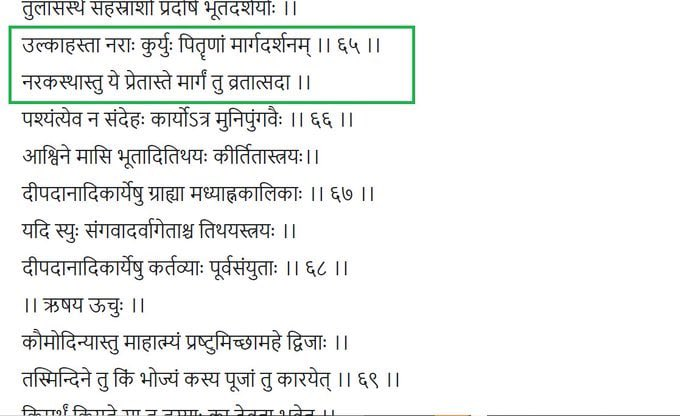
The Skanda Purana says Diwali should be celebrated by holding Ulkas in our hands. This will show path to our ancestors.
What are “Ulkas”? The meaning of this word has changed with time. GV Tagare translates it as “firebrands”.
[Firecrackers in their early form were firebrands]
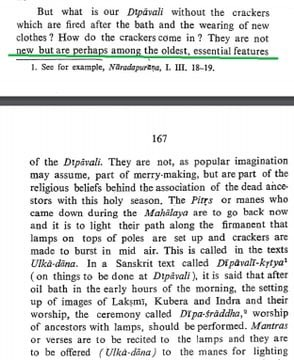

Analysing such verses, professor of Sanskrit and historian Dr. GV Raghavan concludes that (an early form of) crackers have been a part of Dipavali celebrations since earliest times.
He says that their religious purpose was to illuminate & resonate the path of departed pitrs.
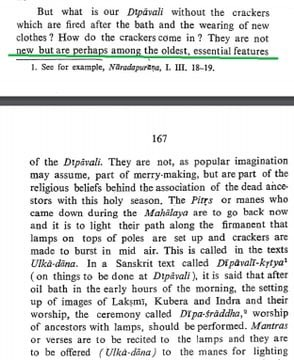
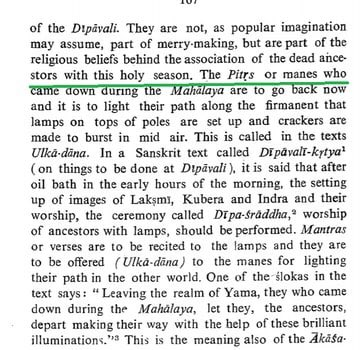
In her thesis, Indologist Tracy Pintchman says that the core of Diwali festivity is illuminating the path of deceased ancestors with firecrackers and lights

This is also corroborated in Ananda Ramayana.
Ananda Ramayana is an epic that has been traditionally been attributed to Valmiki.
It mentions that fireworks were burst during Lord Rama’s homecoming.
It mentions crackers which burst and shine in the sky (gaganantarvirajitan)
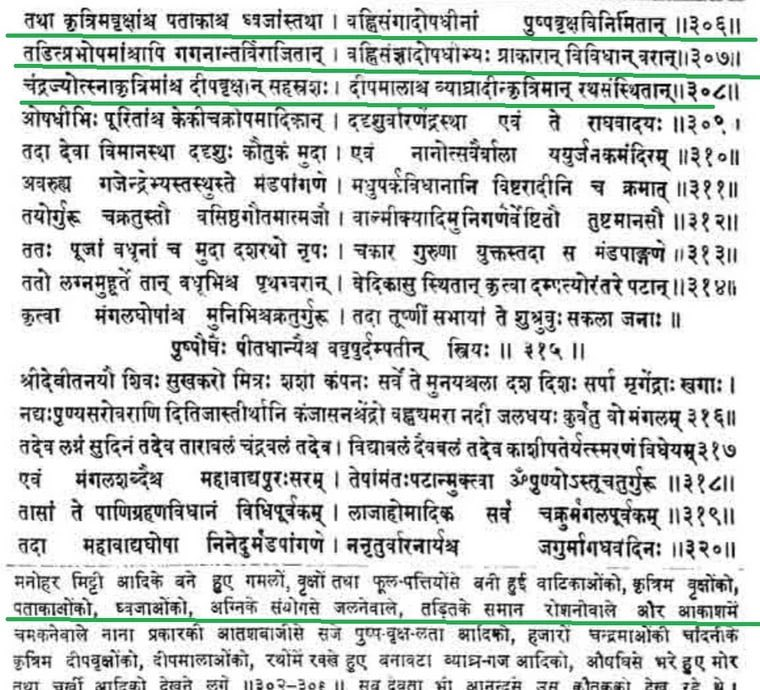
As against this, it is objected that Ananda Rāmāyaṇa is a work of 15th century.
But these dates have been assigned by same Indologists who assigned a date of 500-100 BC (post Buddha) for Valmiki Rāmāyaṇa.
In Hinduism,date doesn’t determine validity.
What does is acceptance of texts among Sampradayas .
Ananda Ramayana easily qualifies such test and is accepted by most Sampradayas. “This practice isn’t old enough,ban it” is Abrahamic. This isn’t really how Hindu tradition operates.
Such an idea could be seen in Medhātithi’s 11th century commentary on Manusmriti 2.6.
He says that a practice (in our case bursting firecrackers), what is actually done with a view to invisible results, by persons learned in the Veda has the authority of Smriti.
Hard archaeological evidence for all festivals has been allusive in a tropical & frequently (re)populated civilization like India.
These are wall murals(of a possibly later date) on 9th century Tyagaraja temple in Tamilnadu.
They depict festival celebrations with firecrackers.


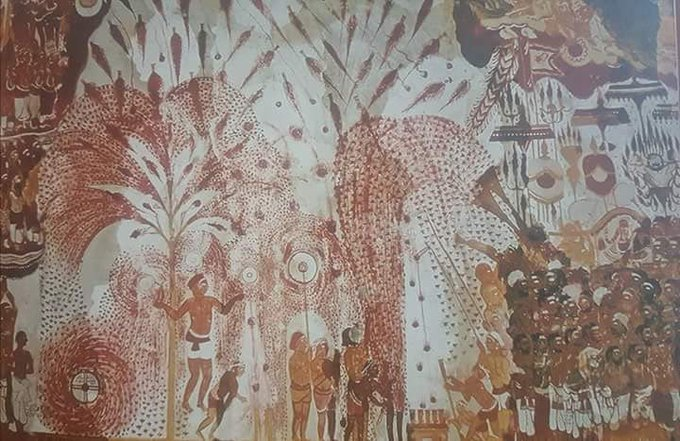
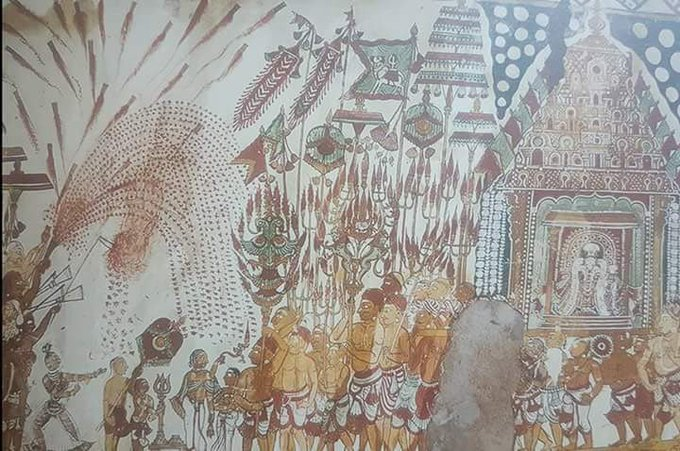
(continued…)
10. Akshai1993
Vedic religion spread via the Brahmins of Kuru-Panchala region mingling and acting as priests to the non-Vedic borderlanders and passed on the Vedic tenets to them without any force. It’s clear from Vedic texts like Jaiminiya Brahmana itself, no need to look anywhere else.

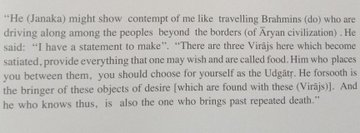
JB 1.245
Medhatithi’s commentary should be relevant in this context. When Arya Dharma expands into foreign lands, Mlechchadesha ceases to be the land of Mlechchas and becomes the land of Aryas, fit for Vedic Yajnas.
This is also a historical reality. Vedic orthodoxy was intiially confined to Kuru-Panchala region, but gradually expanded throughout the other lands of Bharata and even beyond into Central and Southeast Asia at the peak of Hindudom.
11. Ugra
The Achaemenid influence into India is one of the egregious examples of historical inventionism without any archaeological basis. Never has so much (lions, gods, empire-formation, epigraphy, coinage) been propounded by so many (Romila Thapar, Darlymple etc.) with so little!
A 2023 science paper further yanks the floor from beneath the legs of this rather bizarre theorizing that has passed its 7th decade of existence. But first, we look at the claims before getting into the finer details of this paper.
https://link.springer.com/article/10.1007/s12520-022-01537-y
In the History of Early India, Romila Thapar makes what seems to be expansive claims. In reality though, the Achaemenids never refer to the city of Takshashila or Taxila - not even once in the Persepolis Fortification Texts. They did not even have a metonym for the city.
Much more expansive claims follow about the satrapies in North-west India, based on the third-hand account of Herodotus. Again these are all untenable repetitions with no material basis.
Serious historians and archaeologists have always questioned such fables. David Fleming, in 1993, produced a sober paper summarizing the air-gap between claim and reality.
The complete lack of textual corroboration from the Indian side is a red-flag for Fleming, who eventually concludes that a single mound in Taxila may represent the extent of Achaemenid presence in India.
As we now find out in 2023, even that might not have been the case. A new method that traces the lead-isotopic content in silver coins to their sites of provenance provides an objective answer to the question of Achaemenid presence in India.
The backstory - when Alexander serial-defeated the Achaemenid forces at Granicus, Issus and Gaugamela by 331 BCE, there was still one last goal - plundering the royal treasuries at Susa and Persepolis.
After the Battle of the Persian Gate in 330 BCE, the final march to Persepolis took place. There Alexander and his forces seized one of the largest ever silver treasures in human history.
A little over 5000 tons of silver.
How much was the immensity of this treasure? Judge for yourself.
A Greek hoplite’s (soldier) daily wage was 4.3 grams of silver. The treasure represented 1.3 billion daily wages - enough to pay an army of 50000 for more than 60 years. (Blichert-Toft et al, 2022)
So what did they use it for?
Alexander and his Diadochi converted the silver bullion into their own coinage and expanded the money supply in their respective fiefdoms and patronage.
Many of these coins, that were minted from the Persepolis Loot, have survived into modernity - making them available for scientific fingerprinting.
In the ancient world, it was common to find silver, lead (Pb) and zinc naturally occurring together in ores (galena). By verifying the Pb-isotopic data (model ages), it would be possible to accurately trace the provenance of the silver.
Janne Blichert-Toft and team compared the Pb-isotopic data from 4 sources -
(1) silver alexanders; (2) silver sigloi; (3) another subset of Greek coins (4) shatamanas (bent silver bars and imprinted pieces) from Gandhara & Kamboja Janapadas
The Greek and Persian silver coins show a very tight band of model age distributions for the Pb isotopes while the Indian coins provide a very wide scatter of fit.
The diversity of model ages (both -ve & +ve) rule out the possibility of an Indian contribution to the Achaemenid treasury.
In addition, the isotopic data allowed the researchers to trace the source of the Persian silver - to areas in the Aegean, Macedonia and Thrace - which were also Achaemenid satrapy for extended periods.
A highly vital paper - that has ruled out any silver tribute paid to the Achaemenids from the Indian provinces and vice-versa ….also the lack of circulation of Achaemenid bullion in the Indian provinces.
It also has implications for the Indo-Greeks, who ruled later, who did not seem to have any bullion contact with the Greek mainland. The sources of silver and shared coinage between the Indian landmass and the Persian-Greek system seems to be trivial.
Combined with the already meager lack of evidence in archaeology and textual sources, this is yet another nail in the fable of “Achaemenid India”.
12. reconstructions
12.1. Ashokan Prakrit song
12.2. Old Prakrits
Listen to how the four ancient languages of India would have sounded like - Maharashtri, Shauraseni, Gandhari, and Magadhi
13. misc history
13.1. Kumārila Bhaṭṭa comparative linguistics
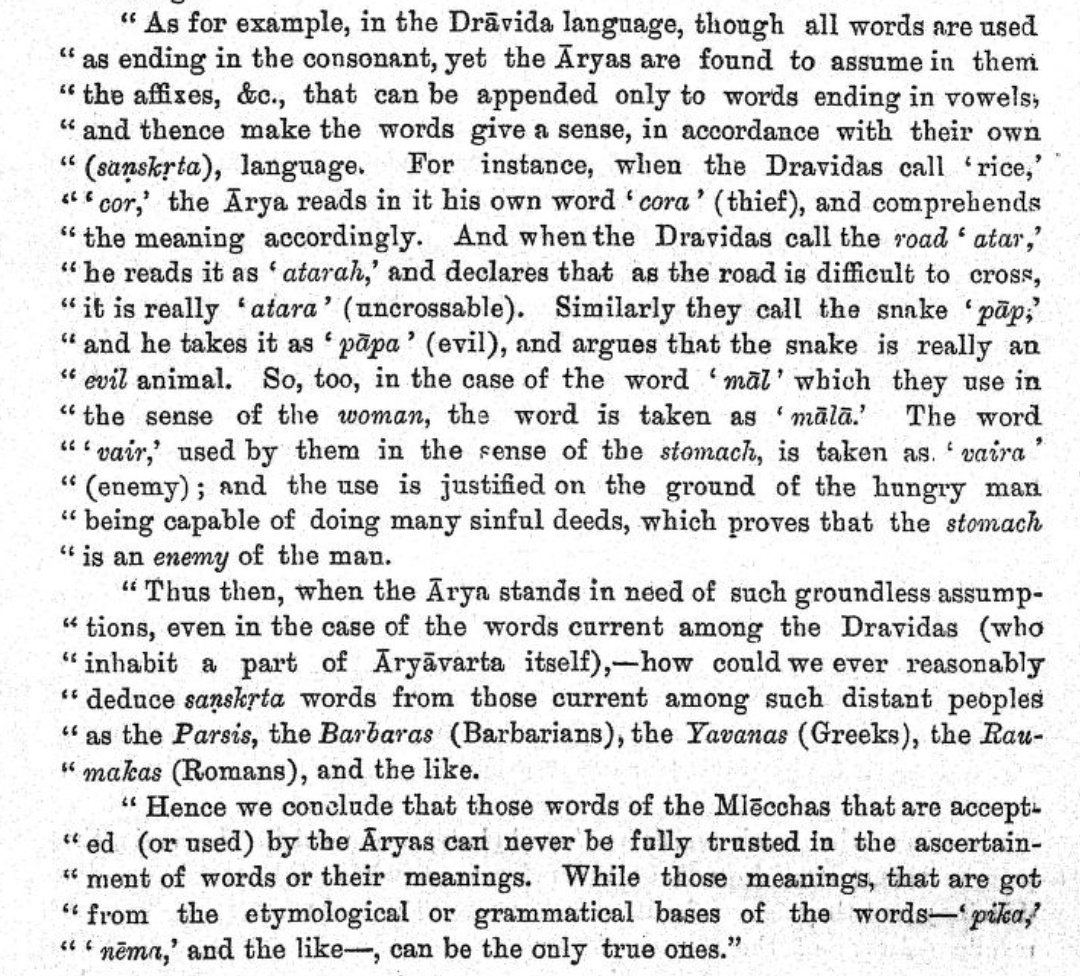
Very interesting passage.
Implies that Indians were aware of parallels between Indian and Iranian/European languages in Kumārilabhaṭṭa’s time (though he downplays it).
Also first passage I know of that acknowledges Drāviḍas/the South as part of Āryāvarta.
13.2. Water wheel
{{{byline-tweet-xhttps://x.com/SchoolVedic/status/557928987314253824,SchoolVedic}}} Description of water wheel by Bhaskaracharya
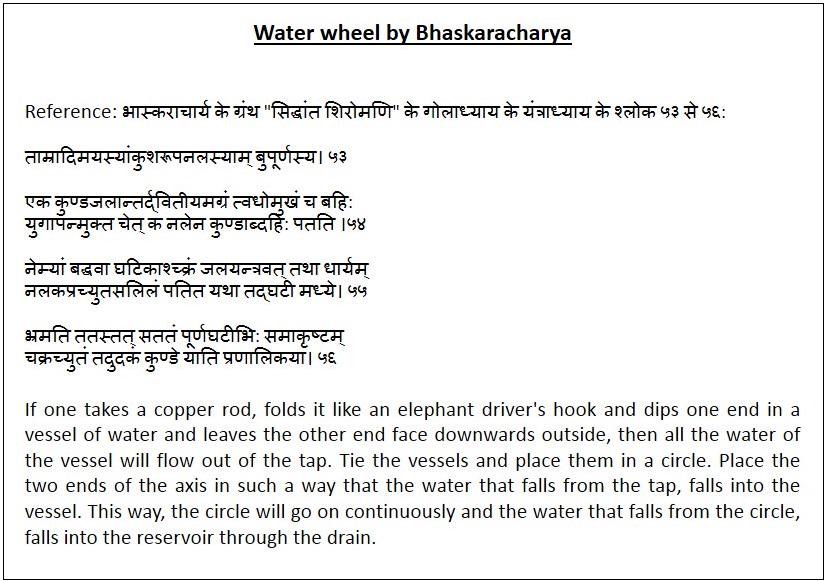
13.3. Mechanical devices in ancient India
Yantras have various meanings based on the context of usage as follows
- mechanical contrivances (machine or instrument) eg., kupa yantra (for drawing water)
- an engine or machine
- astronomical instruments
- mathematical measurement tools (sanku, anka-yantras or numerical diagrams)
- geometrical designs used as tools for meditation (pujana yantras)
- instruments used in ancient surgical procedures
- contraptions or apparatuses used in Ayurvedic system of Rasashastra and Siddha
There has been a large body of work done in all these various fields, except the 4th one for which many mathematical methods were invented, the others require mechanical and technological innovation
13.3.1. Astronomical Instruments
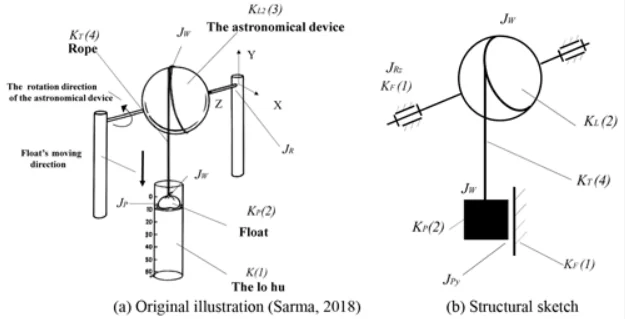
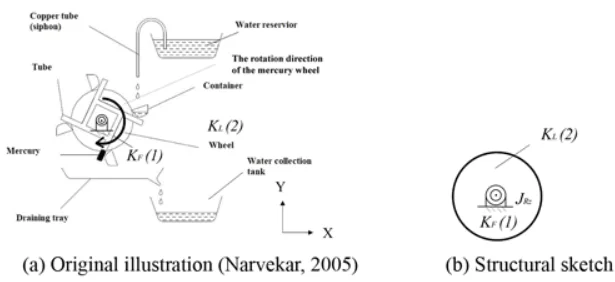
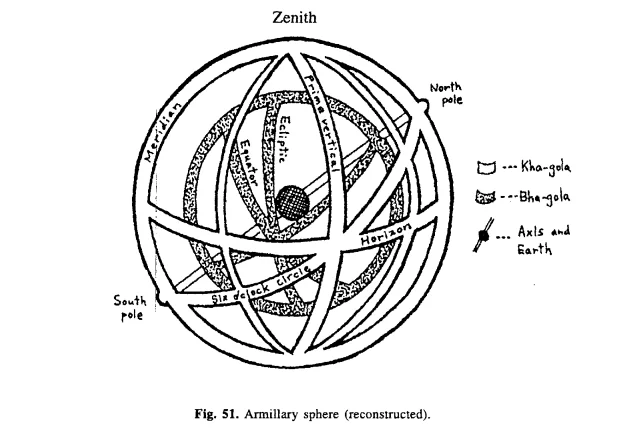
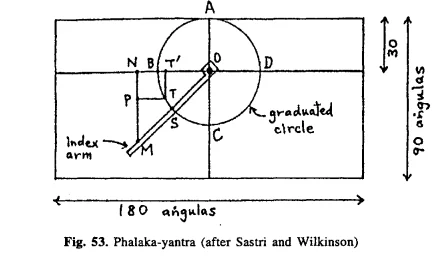
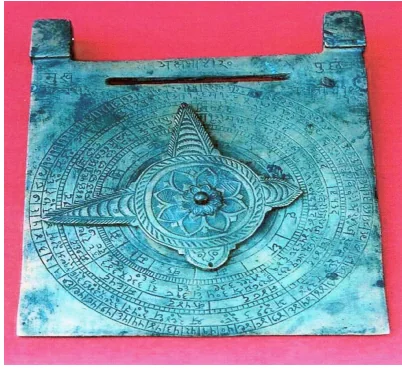
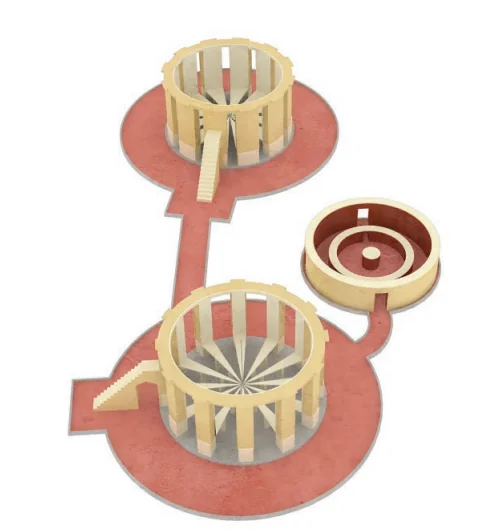 These are some of the examples of various astronomical instruments invented in India, each of them first of their kind and a unique technological achievement.
These are some of the examples of various astronomical instruments invented in India, each of them first of their kind and a unique technological achievement.
First picture is self propelled armillary sphere of aryabhata which was the first float based armillary sphere based on flow of water and float to make it turn. This brings it to the third image which is that of armillary sphere. While greek and chinese armillary sphere predate this one, Indian sphere differs in many ways in design somethings having as many as 57 rings which is not there in china.
The second image is a novel water clock based on concept of perpetual motion first described by brahmagupta, the concept of perpetual motion lead to many new concepts due to investigations into making it possible in europe and India was the source.
5th and 6th devices are those invented by Bhaskara 2 and Padmanabha. Based on spherical trigonometry concepts, phalak yantra(5th device) was invented with same purpose as astrolabe which did not reach india till almost 3 centuries after bhaskara(1300s) and was not as effective, but we can take pride in the fact it was arrived upon independently.
7th Picture is that of Rama Yantra designed by Maharaja Jai singh himself. He along with his guru, jagannath samrat designed a total of 39 instruments which are present in what is now known as Jantar Mantar. While they drew inspiration from early Indian and arabic astronomy, 7 are completely new and their own inventions. Jantar Mantar was one of a kind project with the largest distribution of such masonary instruments as well as the largest surviving observatory, while those of samarkhand and magarah were heavily damaged by invasions. All instruments are the design of Jai Singh and Jagannath samrat and at the time gave the most accurate readings for naked eye observers
13.3.2. Instruments used in ancient surgical procedures
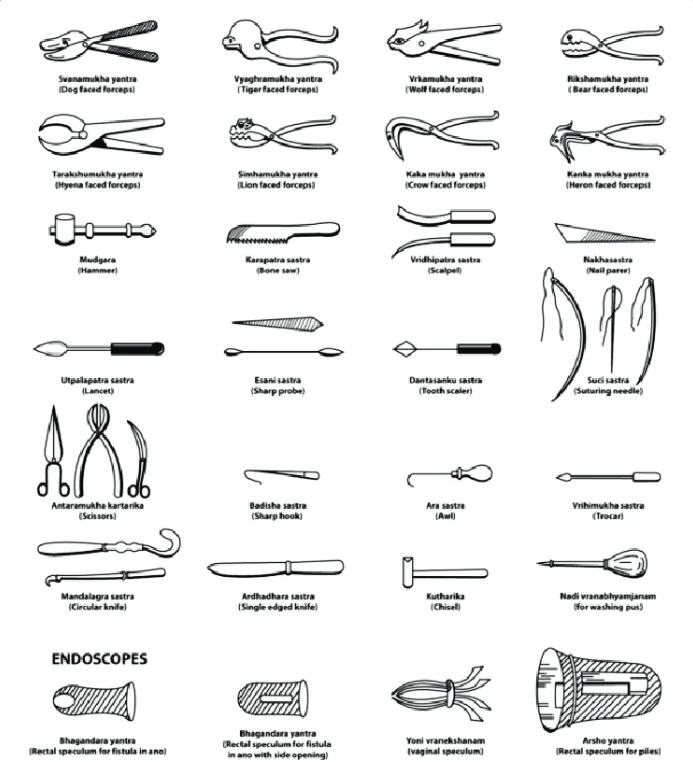 All instruments mentioned in Sushruta samhita, which gives many new surgical procedures
All instruments mentioned in Sushruta samhita, which gives many new surgical procedures
13.3.3. Contraptions or apparatuses used in Ayurvedic system of Rasashastra

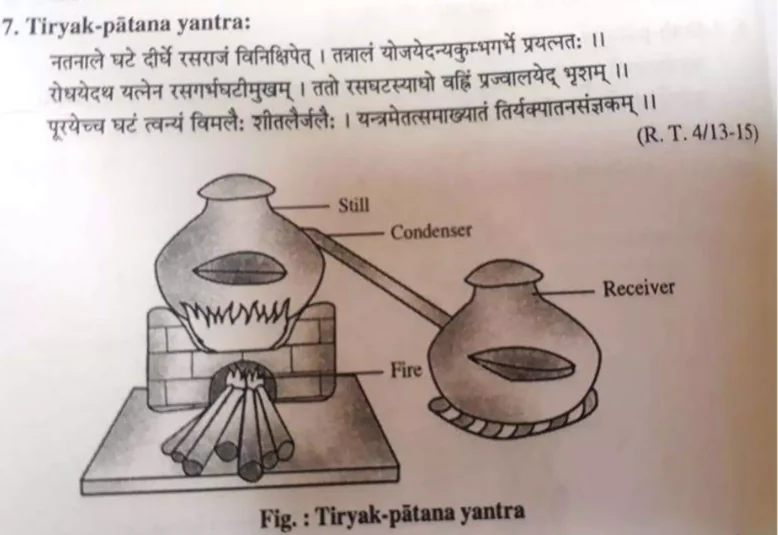
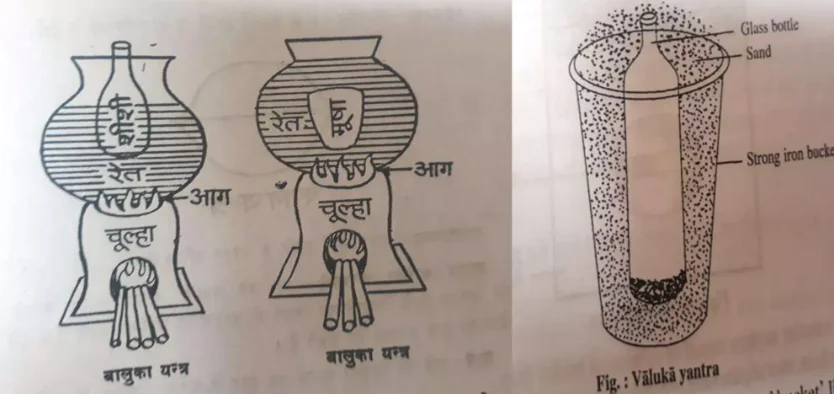
some examples of yantras used in Indian alchemy which is described in Rasayanashastra texts. These have been designed based on hatha yoga principles and poses and India alchemy was used to derive a lot of things. To quote William Durant
“Something has been said about the chemical excellence of cast iron in ancient India, and about the high industrial development of the Gupta times, when India was looked to, even by Imperial Rome, as the most skilled of the nations in such chemical industries as dyeing, tanning, soap-making, glass and cement… By the sixth century the Hindus were far ahead of Europe in industrial chemistry; they were masters of calcinations, distillation, sublimation, steaming, fixation, the production of light without heat, the mixing of anesthetic and soporific powders, and the preparation of metallic salts, compounds and alloys. The tempering of steel was brought in ancient India to a perfection unknown in Europe till our own times; King Porus is said to have selected, as a specially valuable gift for Alexander, not gold or silver, but thirty pounds of steel. The Moslems took much of this Hindu chemical science and industry to the Near East and Europe; the secret of manufacturing ”Damascus“ blades, for example, was taken by the Arabs from the Persians, and by the Persians from India.”
and indian herbal medicine influence east asia and south east asia and middle east and was made possible with these innovations
13.3.4. Mechanical contrivances (machine or instrument) and engine/machine
These have been extensively covered in Arthashastra of chanakya and Samaranga Sutradhara of Bhoja Paramara with input from Yasastilika of Somadeva. Bhoja gives the following rules for making a machine
- yathāvadbījasaṃyogaḥ - Proper and proportionate utilization of constituent elements.
- sauśliṣṭyaṃ - Well-knit construction
- ślakṣṇatā - Firmness of appearance
- alakṣātā - Inscrutability
- nirvahaṇaṃ - Functional efficiency
- laghutvaṃ - Lightness
- śabdahīnatā - Freedom from noise
- śabde sādhye tadādhikyam – A loud noise when noise is intended
- aśaithilyam - Freedom from looseness
- agāḍhatā - Freedom from stiffness
- vahanīṣu samastāsu sauśliṣṭyaṃ - Smooth and unhampered motion
- cāskhaladgati - Production of intended effects in cases where the ware is of curious category.
- yathābhīṣṭārthakāritvaṃ layatālānugāmitā - The securing of the rhythmic quality in motion – particularly in entertainment wares.
- iṣṭakālē’rdhadarśitvaṁ - Going into action when required.
- punaḥ samyaktvasaṁvr̥tiḥ - Resumption of the still state when not required, chiefly in cases of pieces for pastime.
- anulbaṇatvaṁ - Verisimilitude in the case of bodies intended to represent birds, animals.
- tādrūpyaṁ - Firmness
- dārḍhyē - Durability
- asr̥ṇatā - Softness
- cirakālasahatvaṃ - Enduring capacity for a sufficient period of time.
- Samarangana sutradhara also gives the following classification of machines
- स्वयंवाहकम् ॥ Svayamvahakam - That which is automatic and sakrt-prerakam (that which requires occasional propelling)
- अन्तरितवाह्यंम् ॥ Antarita vahyam - Where the principal of action or motor mechanism hidden or concealed from public view with the machine to be carried by another.
- दूरतःवाह्यम् ॥ Duruta vahyam - The one which is really obscure (distant proximate) but carriagable from the place from which the machine acts.
And based on puranic literature many devices were invented and in engine/machine category the following is given
Laghu Dharu Vimana According to Bhojadeva main material of the body of vimana is lightwood-„Laghu Dharu‟, shape of the vimana is that of a huge bird-„maha vihanga‟ with a wing on both the sides. He explains that the internal structure has a fire chamber with mercury placed over flame which acts as a motive force. The power generated by the heated mercury, helped by the concurrent action of the wings which are flapped by a rider inside, makes the yantra go up and travel far. (Raghavan 1952:23-24)
Alaghu Dharu Vimana
While laghu Dharu vimana is in the shape of bird, alaghu Dharu vimana is in the shape of temple. It flies along a heavy aerial car made of wood. It is a heavier Dharu vimana which contains four pitchers of mercury over iron ovens. When mercury i.e. „rasaraja‟ is heated, it explodes quickly and becomes an object of decoration in the sky mainly because of pots heated by the slow ignition burnt within the steel or Iron potsherds.
Whiles these are not possible, the fact that such line of though did exist early is noteworthy and these insights might be potentially useful
Finally another noteworthy ancient Indian invention is Cotton gin, one of the foundational devices of textile industry. Only three processes exist anyway which is ginning, spinning and weaving. The first one is Indian invention, second one is debated and third as of scholarly concensus is chinese inventions(though looms existed earlier and more research is needed due to india being more famous for textiles than china was) and it evolve in india into Worm drive of unknown inventor was another revolutionary invention as worm gearing is now an Indian invention.
For more information
13.4. dīpāvalī
Yes and no. This is not correct understanding of Diwali. Diwali happened even before krishNa killed narakāsura.
Dīpāvalī is essentially culmination of series of rituals Hindus do to propitiate their departed ancestors. On all the days of dīpāvalī, yamarājā is one of the main deities that is invoked and worshipped.
From dhanatrayodashi (we worship yama and dhanvantari - death and doctor in modern parlance) to yamadvitiyā (bhaidooj), the common thread is to say goodbye to our beloved ancestors who had descended on earth to visit us during pitrupaksha. We light Diya and burst fireworks to show them way back to pitruloka.
Rāma’s return to Ayodhya and krishNa’s slaying of Narakāsura on this tithi are both apocryphal and supplementary to the main celebration of Diwali.
Diwali is NOT victory of good over evil. It is about honouring the ancestors and the dèvatā who looks after them (and us when we depart).
One small part but the core of Diwali is worship of dèvī (mostly lakshmi but some places Kālī) on amāvāsyā.
13.5. giraffes
In the 15th century, the Chinese explorer Zheng He made a series of voyages. And he even reached East Africa.
In Bengal (India), he received a giraffe as a gift, which in turn was a tribute received from a kingdom in Kenya.
They mistook it for a mythological being, the qilin.
13.6. agrammes
The Greek accounts describe an Indian ruler called “Agrammes” or “Xandrames” when Alexander was crossing the Indus. This could simply be a corruption of “Agra-mahiṣī.” (अग्रमहिषी)— designation of the Principal Queen - who also plays the role of Regent between successions.
13.7. mumbai
TIL Mumbai is referenced on 1800 year old Greco-Roman maps as ‘Heptasia’ or ‘7 islands’.
A lot of Marathis themselves don’t know that bombay is also derived from bimbasthanaka.
Both Mumbai & Bimbasthan are OG names only.
Named after its founder- Marhattabala Samrat Bimbadev Ramchandra Jadhavrao.
Maternal ancestor of Chh Shivaji Maharaj
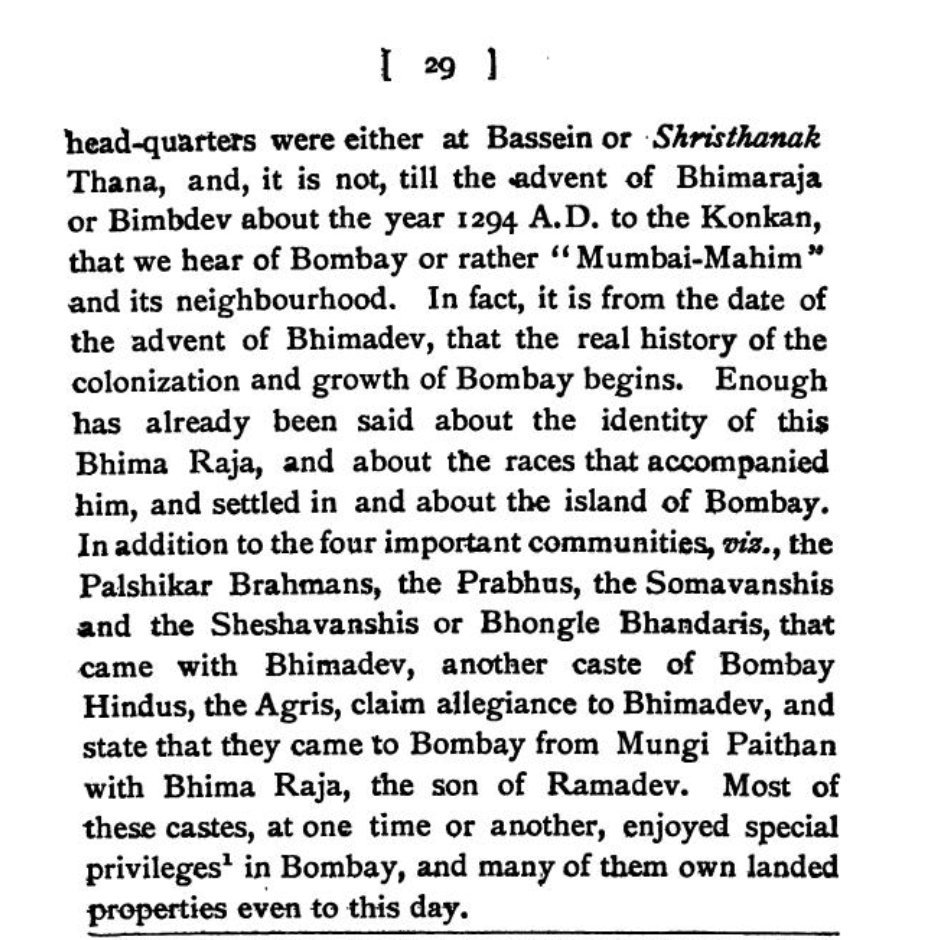
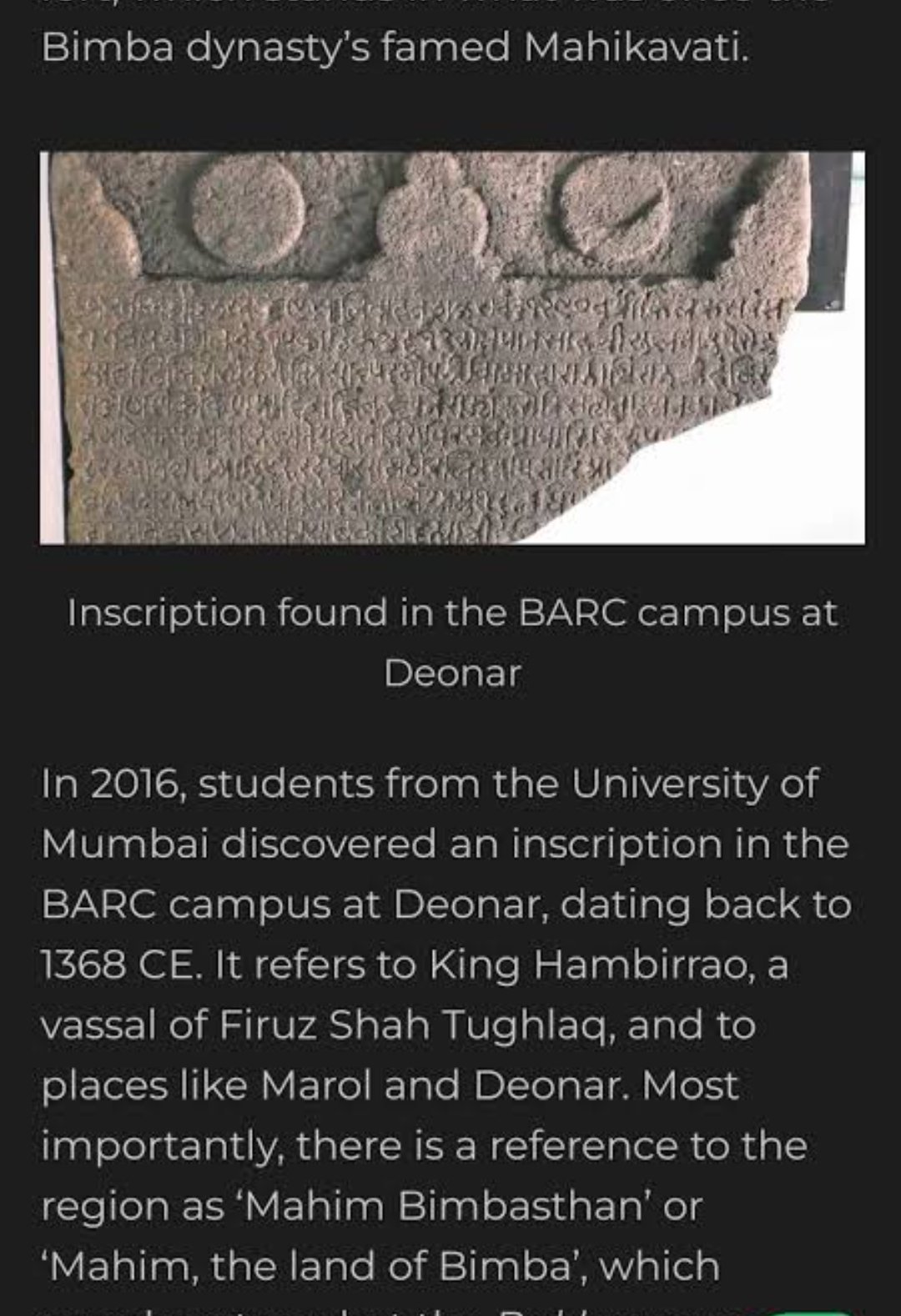
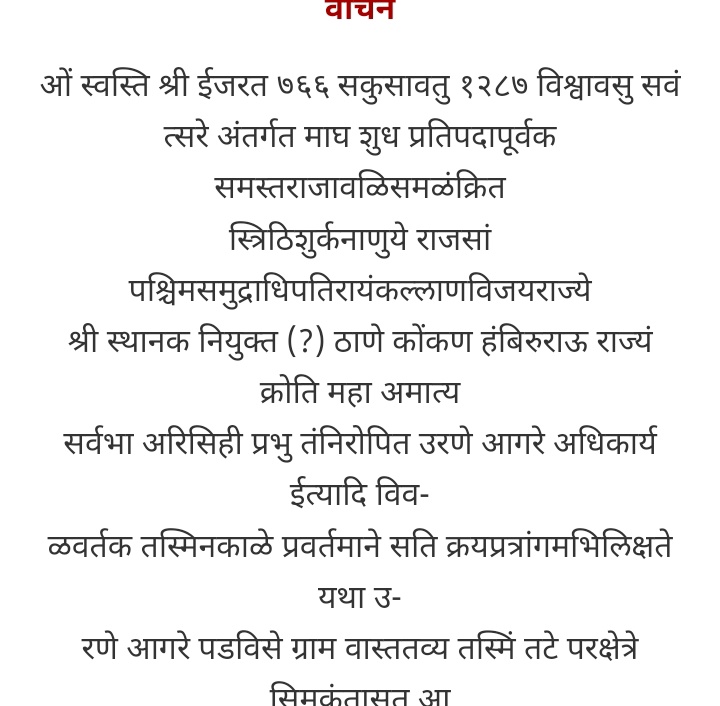
13.8. hun assimilation
Mother of Yashkarnadeva Kalachuri of MP was a Huna princess named Avalladevi. The wife of Rawal Allata of Guhilots (ancestors of Mewar Ranas) was a Huna princess named Hariyadevi. Tells you how slowly and steadily the Hunas were absorbed in the Hindu society. All we wuzz kangz pure blood lineage claims only look good in rhetoric, not on paper.
13.9. muhammad
Researching a Hadith where Mohammed gets gang raped by a bunch of Indian guys but he preaches Islam to them and eventually, by the morning, they are convinced to convert
Then he [Abdullah] mentioned a group of male members [haneen, i.e. men] who looked like Zutt people. ‘Affan narrated (or something like what ’Affan said, Allah willing): They didn’t have any clothes on, and I didn’t see their genitals, and they were tall and scrawny. He [Abdullah] said: And they came and started to ride [yarkaboun] the Messenger of Allah (SAW), and the Prophet of Allah (SAW) began to recite to them. And they started to move closer and lean around me, and get in my way, and I became intensely terrified of them, so I sat down (or something like that). And when the morning light broke, they began to go away (or something like that). Then the Messenger of Allah (SAW) came back exhausted and in pain, or practically in pain, from how they had ridden him; He said: Indeed I am exhausted (or something like that). Then the Messenger of Allah (SAW) put his head in my lap (or something like that). And the men came with tall white garments on, but the Messenger of Allah (SAW) had fallen asleep. And I became more intensely terrified of them than I was the first time. https://sunnah2.com/262
13.10. voltaire on india
https://www.online-literature.com/voltaire/4408/
All the world knows that Pythagoras, while he resided in India, attended the school of the Gymnosophists, and learned the language of beasts and plants.[1] One day, while he was walking in a meadow near the seashore, he heard these words:
“How unfortunate that I was born an herb! I scarcely attain two inches in height, when a voracious monster, an horrid animal, tramples me under his large feet; his jaws are armed with rows of sharp scythes, by which he cuts, then grinds, and then swallows me. Men call this monster a sheep. I do not suppose there is in the whole creation a more detestable creature.”
Pythagoras proceeded a little way and found an oyster yawning on a small rock. He had not yet adopted that admirable law, by which we are enjoined not to eat those animals which have a resemblance to us.[2] He had scarcely taken up the oyster to swallow it, when it spoke these affecting words:
“O, Nature, how happy is the herb, which is, as I am, thy work! though it be cut down, it is regenerated and immortal; and we, poor oysters, in vain are defended by a double cuirass: villains eat us by dozens at their breakfast, and all is over with us forever. What an horrible fate is that of an oyster, and how barbarous are men!”
Pythagoras shuddered; he felt the enormity of the crime he had nearly committed; he begged pardon of the oyster with tears in his eyes, and replaced it very carefully on the rock.
As he was returning to the city, profoundly meditating on this adventure, he saw spiders devouring flies; swallows eating spiders, and sparrow-hawks eating swallows. “None of these,” said he, “are philosophers.”
On his entrance, Pythagoras was stunned, bruised, and thrown down by a lot of tatterdemalions, who were running and crying: “Well done, he fully deserved it.” “Who? What?” said Pythagoras, as he was getting up. The people continued running and crying: “O how delightful it will be to see them boiled!”
Pythagoras supposed they meant lentiles, or some other vegetables: but he was in an error; they meant two poor Indians. “Oh!” said Pythagoras, “these Indians, without doubt, are two great philosophers weary of their lives, they are desirous of regenerating under other forms; it affords pleasure to a man to change his place of residence, though he may be but indifferently lodged: there is no disputing on taste.”[3]
He proceeded with the mob to the public square, where he perceived a lighted pile of wood, and a bench opposite to it, which was called a tribunal. On this bench judges were seated, each of whom had a cow’s tail in his hand, and a cap on his head, with ears resembling those of the animal which bore Silenus when he came into that country with Bacchus, after having crossed the Erytrean sea without wetting a foot, and stopping the sun and moon; as it is recorded with great fidelity in the Orphicks.
Among these judges there was an honest man with whom Pythagoras was acquainted. The Indian sage explained to the sage of Samos the nature of that festival to be given to the people of India.
“These two Indians,” said he, “have not the least desire to be committed to the flames. My grave brethren have adjudged them to be burnt; one for saying, that the substance of Xaca is not that of Brahma; and the other for supposing, that the approbation of the Supreme Being was to be obtained at the point of death without holding a cow by the tail; ‘Because,’ said he, ‘we may be virtuous at all times, and we cannot always have a cow to lay hold of just when we may have occasion.’ The good women of the city were greatly terrified at two such heretical opinions; they would not allow the judges a moment’s peace until they had ordered the execution of those unfortunate men.”
Pythagoras was convinced that from the herb up to man, there were many causes of chagrin. However, he obliged the judges and even the devotees to listen to reason, which happened only at that time.
He went afterwards and preached toleration at Crotona; but a bigot set fire to his house, and he was burnt—the man who had delivered the two Hindoos from the flames? Let those save themselves who can![4]
[1] Perhaps it would be impossible at the present day to convince scientists that oysters formerly conversed intelligibly with mankind and protested eloquently against human injustice; but all men are not scientists, and there are many worthy people who still have implicit faith in ancient Semitic records—who firmly believe in miracles and prodigies—and who would consider it rank heresy to doubt that the serpent, though now as mute as an oyster, formerly held a very animated conversation, in the original Edenic language, with the inexperienced and confiding female who then graced with her charming presence the bowers of Paradise; and this sacred narrative of the “maiden and the reptile” is quite as repugnant to modern science as the sentimental fish story of “Pythagoras and the oyster”.
As a matter of fact, the doctrine of the metempsichosis, as taught by the Samian sage, was formerly held in great repute by the most civilized nations of antiquity, and it is surely as easy to credit the assertion of our author, that the ancient Gymnosophists “had learned the language of beasts and plants” as to believe the unquestioned and orthodox statement that a certain quadruped, (Asinus vulgaris,) —whose romantic history is recorded in the twenty-second chapter of Numbers,—was once upon a time able to converse in very good Hebrew with Monsieur Balaam, an ancient prophet of great merit and renown.—E.
[2] The resemblance of oysters to mankind, here implied, can only be apparent to the “eye of faith,” and lovers of these delicious bivalves will fail to recognize the family likeness.—E.
[3] Pythagoras was born at Samos, about 590 years before the Christian era. He received an education well calculated to enlighten his mind and invigorate his body. He studied poetry, music, eloquence and astronomy, and became so proficient in gymnastic exercises, that in his eighteenth year he won the prize for wrestling at the Olympic games. He then visited Egypt and Chaldea, and gaining the confidence of the priests, learned from them the artful policy by which they governed the people. On his return to Samos he was saluted by the name of Sophist, or wise man, but he declined the name, and was satisfied with that of philosopher, or the friend of wisdom. He ultimately fixed his residence in Magna Gr�cia, in the town of Crotona, where he founded the school called the Italian.
This school became very prosperous, and hundreds of pupils received the secret instructions of Pythagoras, who taught by the use of ciphers or numbers, and hieroglyphic writings. His pupils were thus enabled to correspond together in unknown characters; and, by the signs and words employed, they could discover among strangers those who had been educated in the Pythagorean school. All the pupils of the philosopher greatly reverenced their teacher, and deemed it a crime to dispute his word. One of their expressions “thus saith the Master,” has been adopted by modern sects.
The Samian sage taught the doctrine of the metempsichosis, or the transmigration of the soul into different bodies, which he had probably learned from the Brahmins; who believed that, in these various peregrinations, the soul or thinking principle was purged from all evil, and was ultimately absorbed into the Divine substance from which it was supposed to have emanated.
Godfrey Higgins in the Anacalypsis cites authorities to prove that the doctrine of the metempsichosis was held by "many of the early fathers of the Christians, which they defended on several texts of the New Testament. It was held by Origin, Calcidius, Synesius, and by the Simonians, Basilidians, Valentiniens, Marcionites, and the Gnostics in general. It was also held by the Pharisees among the Jews, and by the most learned of the Greeks, and by many Chinese, Hindoos and Indians.
“When all the circumstances relating to Pythagoras and to his doctrines, both in moral and natural philosophy, are considered,” continues Higgins, “nothing can be more striking than the exact conformity of the latter to the received opinions of the moderns, and of the former to the moral doctrines of Jesus Christ.”
“The pupils of Pythagoras,” says Eschenburg, Manual of Classical Literature, “soon amounted to 600, dwelt in one public building, and held their property in common. Under philosophy, the Italic school included every object of human knowledge. But Pythagoras considered music and astronomy of special value. He is supposed to have had some very correct views of astronomy, agreeing with the true Copernican system. The beautiful fancy of the music of the spheres is attributed to him. The planets striking on the ether, through which they pass, must produce a sound; this must vary according to their different magnitudes, velocities, and relative distances; these differences were all adjusted with perfect regularity and exact proportions, so that the movements of the bodies produced the richest tones of harmony; not heard, however, by mortal ears.”
Pythagoras taught, and his followers maintained, the absolute equality of property, “all their worldly possessions being brought into a common store”. The early Christians had also “all things in common,” and the doctrines of Jesus and Pythagoras have many points of resemblance. Both were reformers, both sought to benefit the poor and the oppressed, both taught and practised the doctrines now known as Communism, and both, for their love to the human race, suffered a cruel martyrdom from an orthodox and vindictive priesthood.
In obedience to an oracle, the Romans, long after the death of Pythagoras, erected a statue to his memory as the wisest of mankind.—E.
[4] Godfrey Higgins in the Anacalypsis draws aside the veil of Isis, and explains in a satisfactory manner the reason why Pythagoras, like Socrates and Jesus, was condemned to death by the established priesthood. Each of these great reformers had been initiated into the sacred mysteries, and each taught his followers by secret symbols or parables that contained a hidden meaning; so “that seeing the uninitiated might see and not perceive, and hearing might hear and not understand.” The reason that Jesus gave for following this method was “because it is given unto you (i.e. the initiated) to know the mysteries of the kingdom of heaven, but to them (i.e. the people) it is not given.” (Matt. XIII: II.) The mass of mankind, being excluded from this secret knowledge, were kept in a state of debasement as compared with the favored few who were acquainted with the jealously guarded secrets of the Cabala; and the earnest desire of these great reformers—of these noble men who cheerfully gave their lives to benefit their race—was, without divulging the secrets of their initiation, to teach mankind to partake of the forbidden fruit of the tree of knowledge, and to learn “that a virtuous life would secure eternal happiness.” Such philanthropic doctrines were denounced as wicked and heretical by the orthodox priesthood, who instinctively oppose human progress, and who, like the silversmith of Ephesus, described by St. Paul, felt that “this our craft is in danger” should the people become enlightened. They therefore, excited a popular clamor, and aroused the worst passions and prejudices of their followers; who, inspired with fanatic zeal, cruelly and wickedly burned Pythagoras of Crotona, poisoned Socrates of Athens, and crucified Jesus of Nazareth.—E.
13.11. Chanakya Neeti is just Neetisaar from Garuda Purana
13.12. Famines never visited India
’Dharma or something’ indeed. Megasthenes notes in his much-quoted work that “famine has never visited India”. R. Ganguli’s paper published by BORI (1933-34) suggests that India’s decline in food security coincides with the invasion of the Huns (5th/6th century CE). However, recurrent famines were unknown until nearly nine centuries later. In fact, only two significant famines occurred during this period—one in Kashmir in 917-18 CE and another in the Delhi region during the reign of Muhammad Tughlaq. According to Zia Barani, the latter was caused by excessive land taxes, leading to the devastation of cultivators. From the time of Babur, famines became more frequent and widespread, culminating in the most severe famine in history, which occurred in 1899-1900 CE. The paper delves into the major factors contributing to famines like forest & rainfall, irrigation & method of cultivation, agricultural land & population, cattle & bullock power and transport facilities & export. The paper concludes that “in olden days, conditions were distinctly far more unfavourable to the occurrence of famine than they are so now” and “in ancient India, famines were much less frequent and usually much less terrible in character than now.”
this coincides with the observation that late anupam mishra made regarding ponds.
no. of ponds & people indulging in pond economy saw a rapid decline and disorganization from medieval
secular classic sanskrit literature indicates an abundance of ponds/near absence of famines.
13.13. mumbai etymology
From Borivali to Goregaon, names of Mumbai’s local areas can be traced to both Dravidian and Indo-Aryan languages. Truly cosmopolitan!
(Picture from ’Early Indians’ by Tony Joseph)
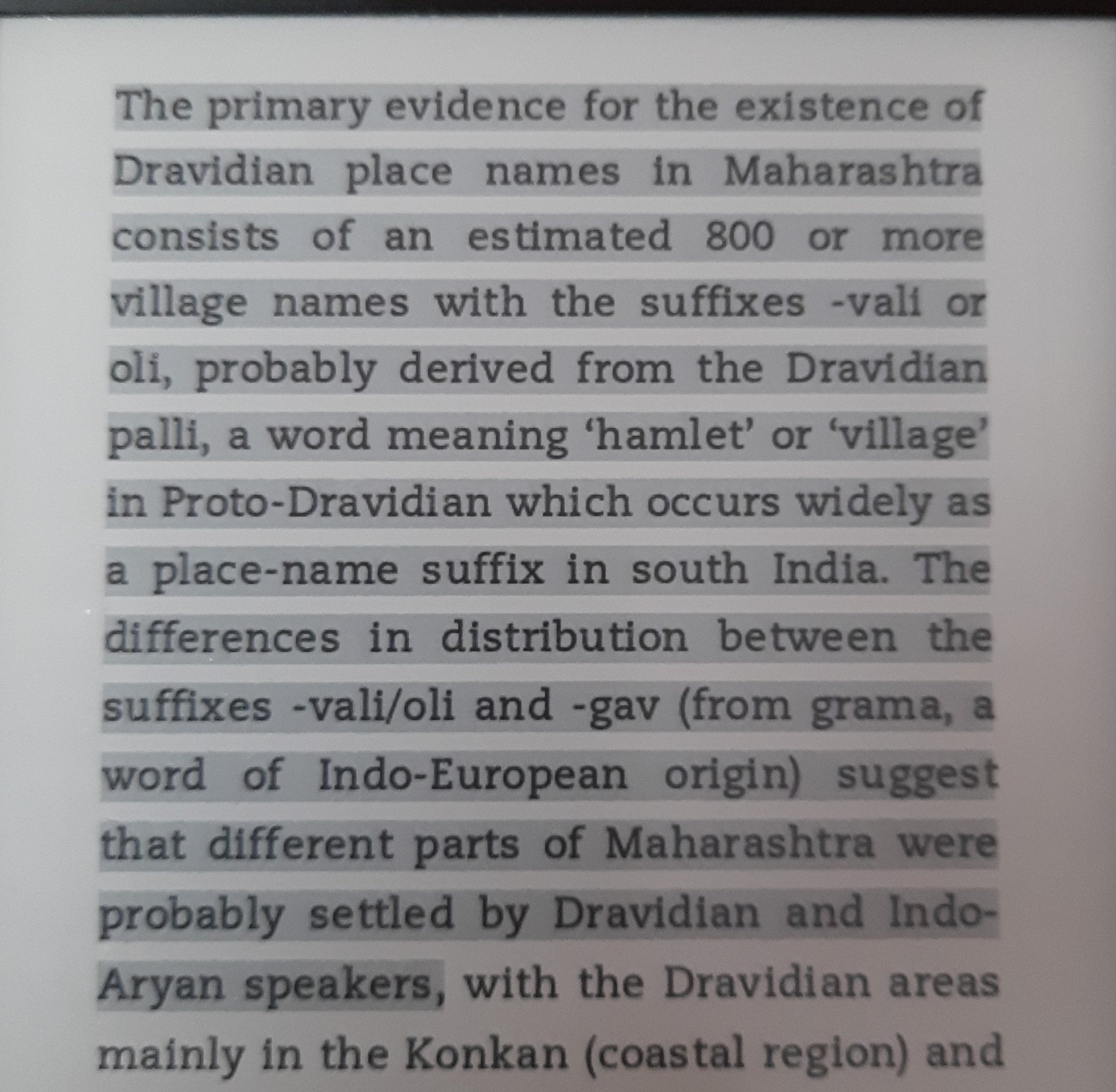
13.14. darlymple epstein
This pie-chart is good …
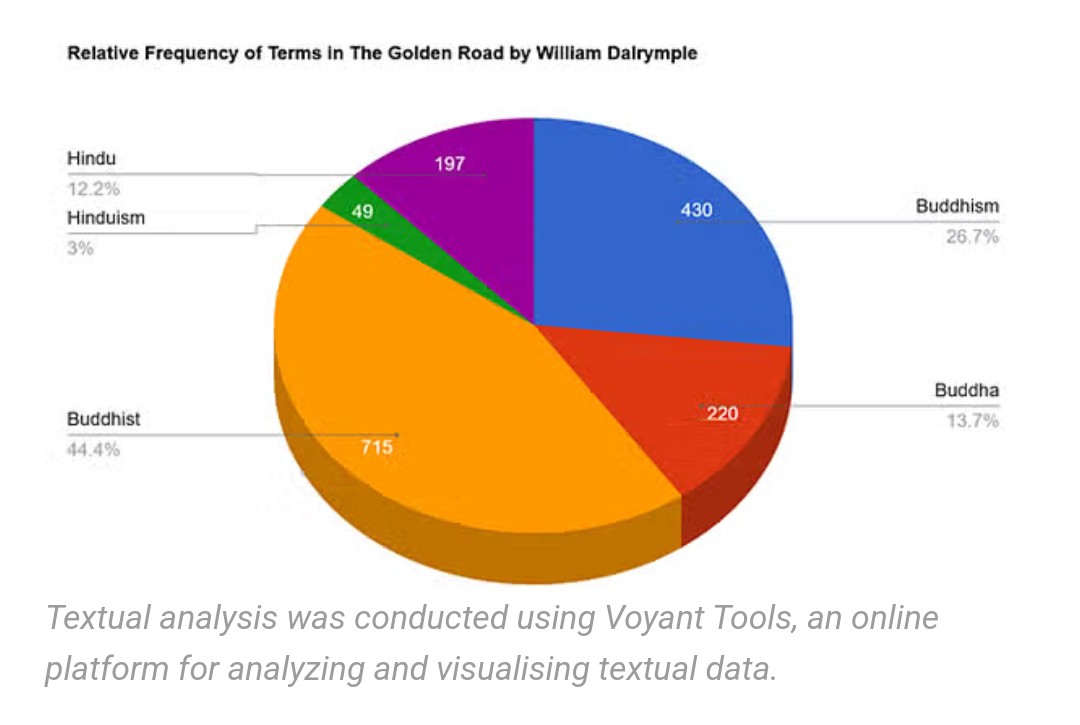
Followed by this passage..
“…Dalrymple is not alone in painting such a weird, exotic image of Hinduism to justify the rise and spread of Buddhism. The entire subaltern school since Ambedkar’s time has used the same stereotypes to chastise Hinduism and project Buddhism as the utopian and egalitarian alternative”